 By Pepper Parr By Pepper Parr
October 12th, 2020,
BURLINGTON, ON
Community Development Halton (CDH) is not an organization that is immediately recognized when the letters CDH are mentioned.
It is one of a number of non-governmental organizations in place to serve the community.
It relies on public money to exist – most of the funding comes from the Region of Halton and the United Way.
 Like all the other incorporated not for profit organizations – it holds an annual meeting. Like all the other incorporated not for profit organizations – it holds an annual meeting.
CDH did something startling at its Annual General Meeting earlier this month.
When the province made changes to the Not-For-Profit Corporations Act, many organizations amended their by-laws, reducing voters to board members only – CDH followed suit a few years ago. However, when the current board reflected on the impact to its transparency and inclusiveness, it voted to reverse the change. What CDH has done is re-open the organization to membership – which is what elects the Board of Directors that sets policy and direction.
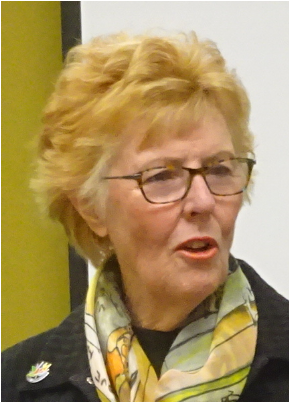 CDH president Jan Mowbray. “They amended the rules related to membership. There are now two forms of membership: Individual and Organization” explained CDH president Jan Mowbray.
“Organization” means any non-profit or charitable organization; grassroots group, or public or private entity, but does not include a political party or political organization.”
“A member must live or work in the Region; members must pay the membership fee.”
The membership fee structure for individuals has yet to be confirmed – however, the members of the Board pay an annual fee of $100.
“Each individual member and a single representative of a member organization shall be entitled to cast one vote on each question at any Annual General Meeting or Special Meeting, provided that the individual or organization was a member in good standing on December 31 of the prior year and remained so for the period up to and including the date of the Annual General Meeting.”
The AGM is always in September – thus preventing any last minute attempt to add new members and change the direction of the organization.
“Ten percent of the membership can petition the President to call a meeting of the Board.”
“A quorum at an Annual General Meeting shall be more than 10% of CDH members in good standing.”
“A motion or resolution shall be carried if it is approved at an Annual General Meeting by more than 50% of those voting.”
There are far too many organizations in place to serve the city that use the Directors in place as their membership – they keep re-electing themselves or determine who they want to join the Board. They become the “old boys club”.
This is a very healthy change, hopefully one that will be taken up by other Not-for-Profit organizations with the Sound of Music (SoM) being an organization that needs a change. There was a time when there were more than 100 SoM members.
In the past far too many NGO’s suspended membership and changed their constitutions to having the members of the Board being the only members who could re-elect themselves at will.
The logic behind changing the rules was that “the board was unanimous in its desire to be completely inclusive and transparent. When only the board could vote on an issue, it left our stakeholders with no say at all in an organization that represents all of Halton”, said Jan Mowbray, President of the CDH Board of Directors.
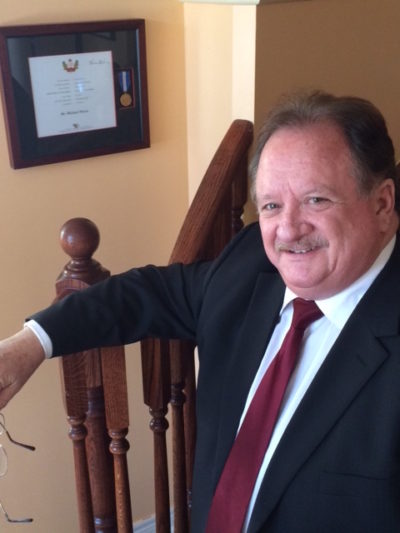 Executive Director Mike Nixon CDH also has a new Executive Director – Mike Nixon – who was in complete support of the change. A number of Staff changes were made as well. COVID issues meant putting some staff on furlough for a period of time.
The organization has now completed the needed structural changes.
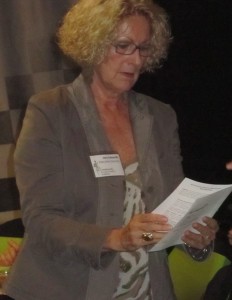 Dr. Joey Edwardh Dr. Joey Edwardh, who retired last October after more than twenty years at the helm during which time some significant changes were made in the way social issues were deliberated upon at a public level.

 By Pepper Parr By Pepper Parr
October 7th, 2020
BURLINGTON, ON
The increase in COVID infections in the community has led the Old Timers Hockey Club to suspend games until further notice.
In a statement released early this morning the Club said: “ there has been an increase in coronavirus cases in our community. As a result of this, we too have experienced a number of positive tests over the last couple of days with some of our members. These positive tests have affected other members and has the potential of continuing to spread.
 “With this in mind, we discussed this issue, its impact on our members, the community and the Club and went through a variety of options of what we should do. Out of an abundance of caution, we have therefore decided to suspend the season at this time. “With this in mind, we discussed this issue, its impact on our members, the community and the Club and went through a variety of options of what we should do. Out of an abundance of caution, we have therefore decided to suspend the season at this time.
“We did not make this decision lightly and did so with the interest of all of our members’ health and safety in mind. The board of directors will be meeting to discuss this decision further and provide you with details regarding refunds; we ask for your patience in the meantime.
If you are concerned in any way about your personal health, please contact your health practitioner. To access Halton Regional Health advice click here
We will continue to monitor the current situation, learn from this experience and consider the club’s further options.
As of immediately however,
• ALL games have been cancelled.
• As mentioned, we will address refund details at a later date.
• Hectors is closed until further notice.
• The ice that we had contracts for is NOT available to players to use tonight and will not be ours going forward.

 By Staff By Staff
October 6th, 2020
BURLINGTON, ON.
It was too good to last.
Or was it a case of the perk being abused by too many people – with the downtown merchants who were originally getting a benefit that over time got away from them.
The result is to ask that Council approve a decision to eliminate the free parking that was available for all of the month of December,
Every program or service has to meet at least one of the visions that make up the Vision to Focus Alignment: Focus Area 5 – Delivering customer centric services with a focus on efficiency and technology transformation.
In promoting the Free Parking service someone at city hall got really creative and put together a very funny 35 second video. Check it out
The downtown business community as the city’s customer, requested a change in the parking service provided.
The Downtown Parking Committee (DPC) was established on November 11, 2002 as a citizen advisory committee of council. The mandate of the DPC is to:
• To provide comments and advice to Council on strategies and policies that affect the development and delivery of parking services in Downtown Burlington
• To consider the community’s interests regarding parking in Downtown Burlington and assist Council in addressing those concerns.
On June 17, 2013, Council approved changes to on-street and municipal facility parking, which approved free parking for all on-street meters and in municipal parking facilities in the Defined Parking Area in downtown Burlington for the month of December.
The intention of this initiative was to improve the parking experience and support economic activity, special events, tourism, and visitor activity in the downtown throughout the month of December.
 Get used to this experience in December. The program was well received by the downtown business community. However, over the past several years, the benefit of the program has been challenged and in December 2019, the DPC was informed that the consensus among the Burlington Downtown Business Association (BDBA) membership was that the program is no longer achieving the original goal, and additionally, that the reduced turnover in parking spaces observed during the Free P period has in fact, become detrimental to business activity.
The DPC agreed on a motion to pause the December Free P! initiative to allow the committee to review options to revise the program. The BDBA circulated a survey to all membership, requesting their feedback and personal experience on the program. The survey consisted of three options:
1. Cancel the program
2. Modify the program
3. Status Quo
As a result of the response, the Burlington Downtown Parking Advisory Committee held a special meeting on March 3, 2020 where the findings of the survey were presented.
While modifications to the program were considered at length, consensus was reached that given the current parking occupancy levels in the downtown, both visitors and businesses would benefit more from the turnover of parking spaces that paid parking would encourage.
 Too many downtown merchants took advantage of the free parking; city staff were taking up so much of the space that the city manager at the time had to put out as memo bringing that practice to a halt. City of Burlington Transportation Services staff serve in a support capacity to the DPC. Staff consider the DPC and BDBA as the voice of the downtown business community and will support the decision to discontinue the December Free P! parking program.
December Free P is no longer fulfilling its intended purpose and moreover has lowered turnover rates which is considered detrimental to business activity.
The downtown municipal parking service functions with a net zero annual operating budget. Net revenues in excess of expenses are allocated to the Downtown Parking Reserve Fund. Should expenses exceed revenues, funds are withdrawn from the reserve fund to ensure that the downtown parking service continues to be self-sufficient.
 When the Free P program was implemented the annual cost of permits was charged over 11 months of the year and each permit holder saw an increase in the monthly fee. With the termination of the Free P program, permits will now once again be collected over 12 months thereby reducing the cost of the monthly permit. When the Free P program was implemented the annual cost of permits was charged over 11 months of the year and each permit holder saw an increase in the monthly fee. With the termination of the Free P program, permits will now once again be collected over 12 months thereby reducing the cost of the monthly permit.
Eliminating the Free P program will bring in additional paid parking revenues, which would contribute to the parking reserve fund.
Staff will work with the Communications Department to develop appropriate communication and media releases.
Council’s decision on these matters will be communicated to stakeholders and the community through the Downtown Parking Committee membership, a media release, a marketing campaign and the city’s website
The proposed amendment to By-law 39-2016 is supportive of the DPC’s recommendation to remove December Free P.
That should get it through Committee and on to Council.

 By Pepper Parr By Pepper Parr
October 5th, 2020
BURLINGTON, ON
The first of the Public presentations of a new development under the new rules took place last week.
The new rules require a developer to present their plans to the public and get feedback before taking their project to the Planning Department.
The rules are a little on the complex side and were the subject of some debate, which we cover in a separate article.
The presentation was done by the ADI Development Group and was focused on the second stage of their Station West development. The first stage is well underway – the developers said that there are already people moving in.
Something about that first phase – it is huge. Unless you drive north on Waterdown Road from Plains Road you might not see it. But drive north on Cooke or along Masonry Court and there it is – right in front of you. Cooke is extended right into the site of what amounts to six lengths of row housing.
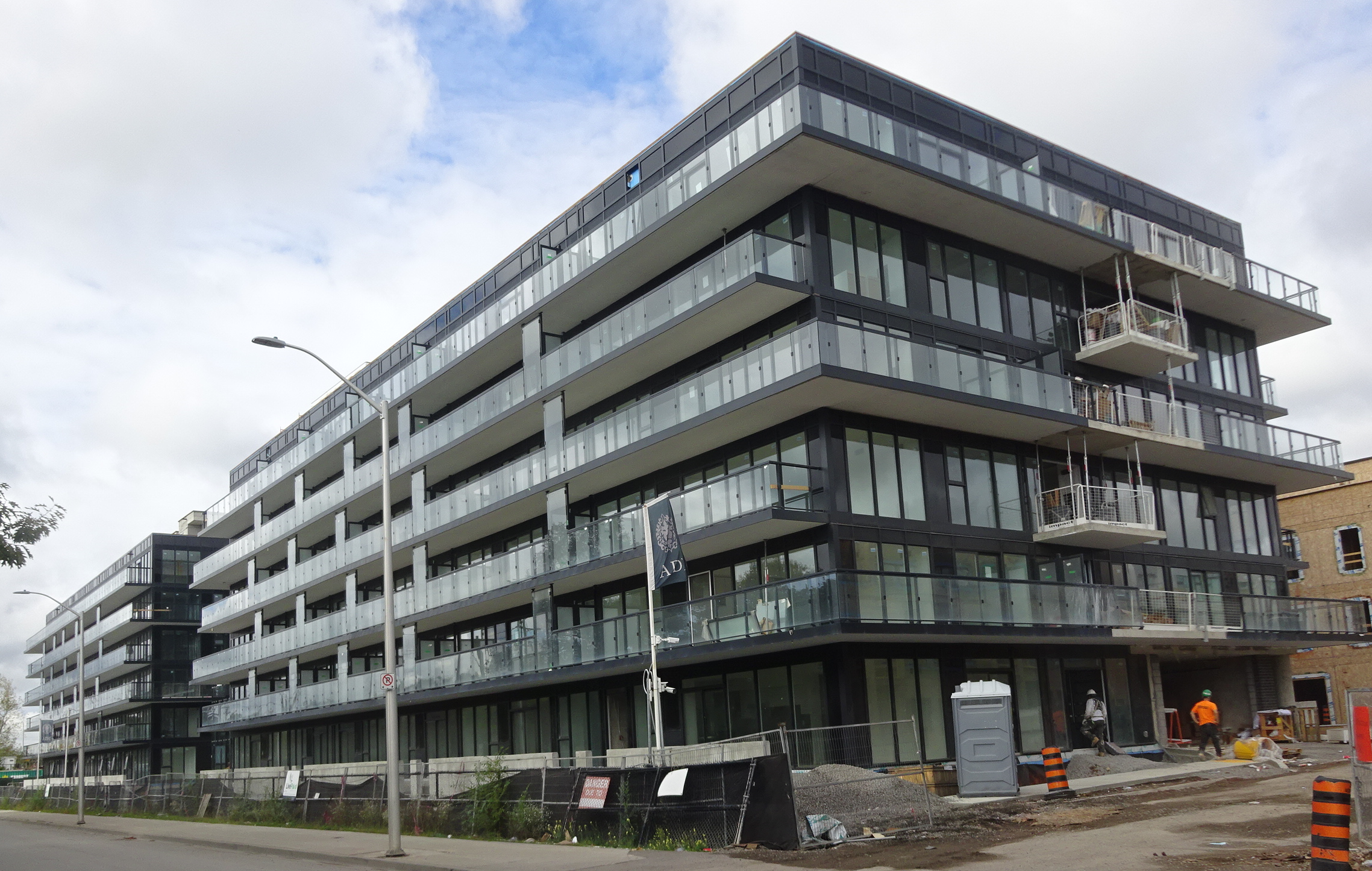 The two structures are joined by a lobby area where the elevators are located. We weren’t able to determine just how many elevators there are. 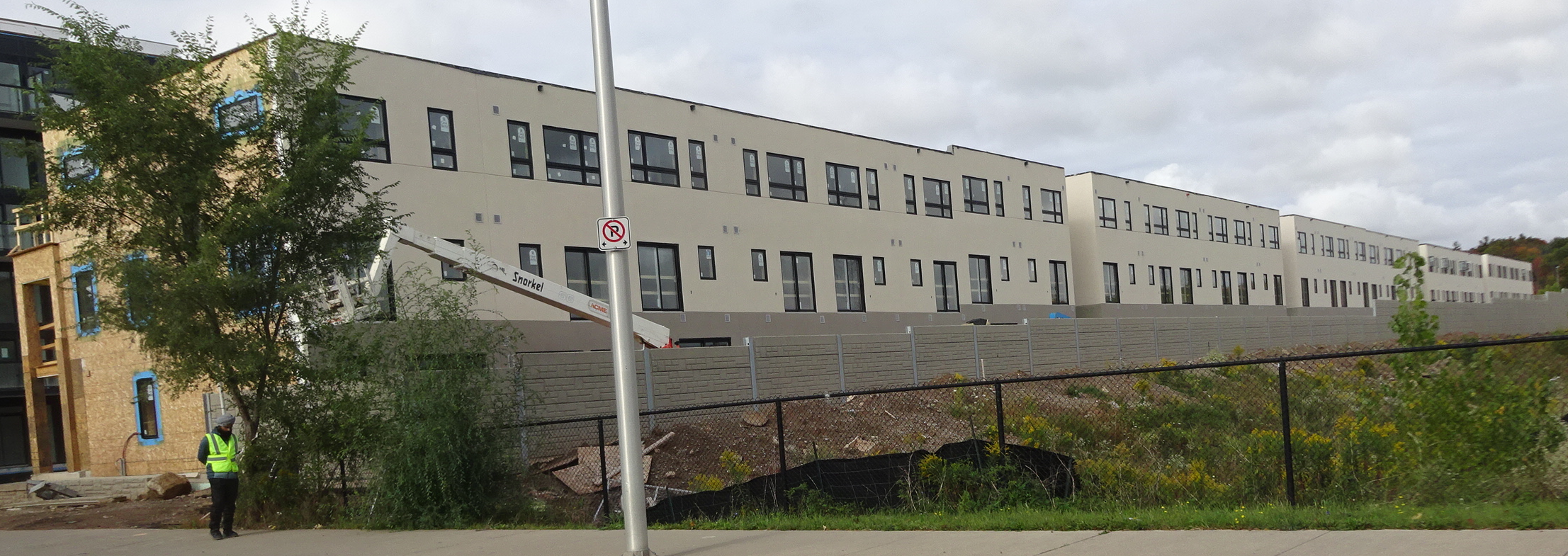 This is the eastern boundary with the Aldershot GO station a short walk away. This is what intensification looks like. 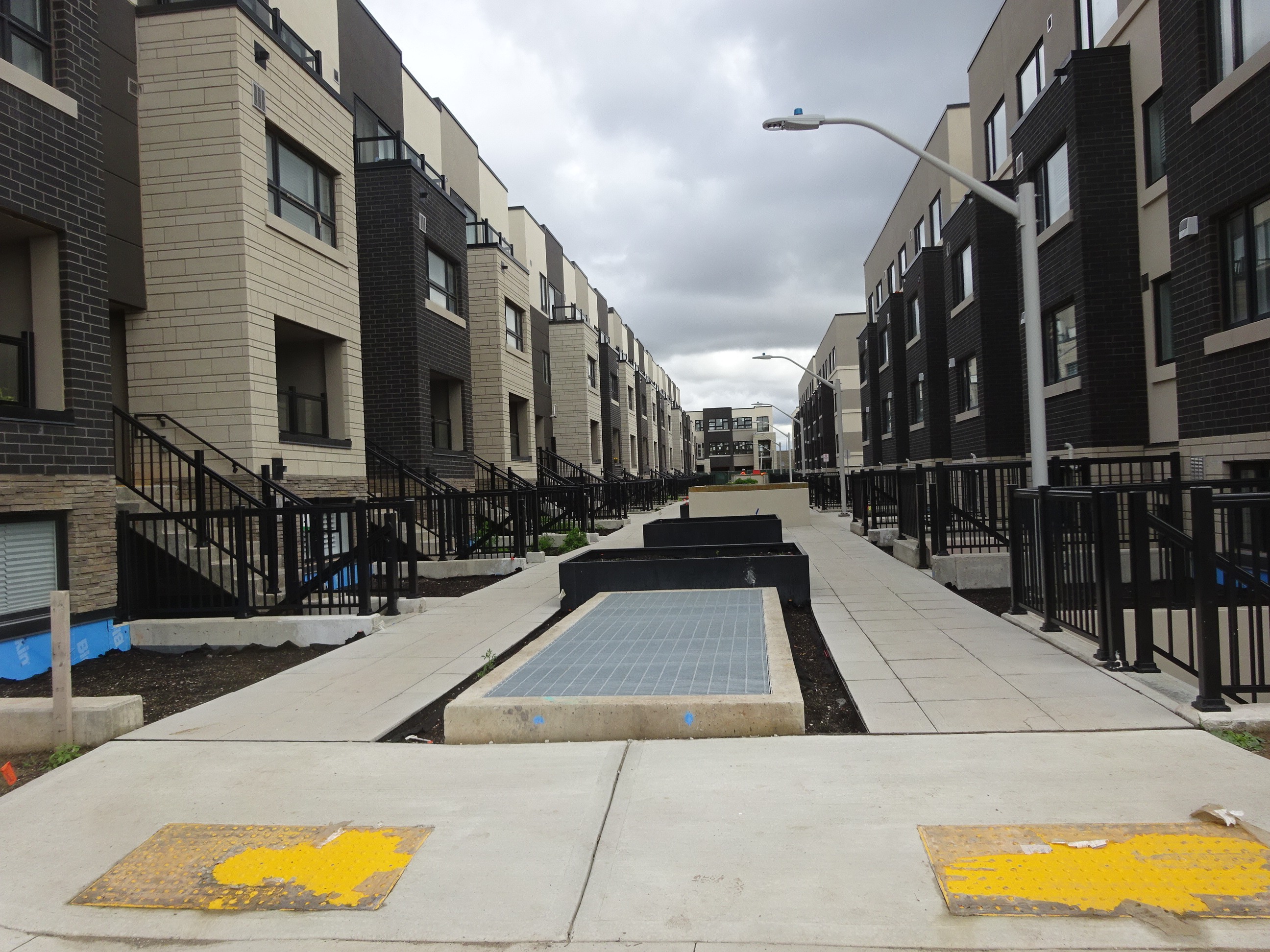 Reasonably attractive, underground parking, basement units with a separate entrance – but it is still row housing with precious little in the way of grass. The meeting was to talk about phase two which is projected to be four towers (but it could be three) with heights of between 18 and 39 storeys.
What strikes anyone looking at the development is – where is the parkland?
 Architectural rendering of the the tower option for phase two of Station West. Where is there any retail?
Those questions didn’t get answered during the hour and a quarter virtual presentation.
More on that in a separate article.
The presentation itself was not all that bad.
There were three people who could be described as public taking part. That was probably because there was very little in the way of public notice.
The Gazette did a short piece two days before – not much time for people to read up on the development and prepare their questions.
The meeting was to get public input on phase two – the first phase is a done deal.
The developer was offering two versions: one with three towers, a second with four towers.
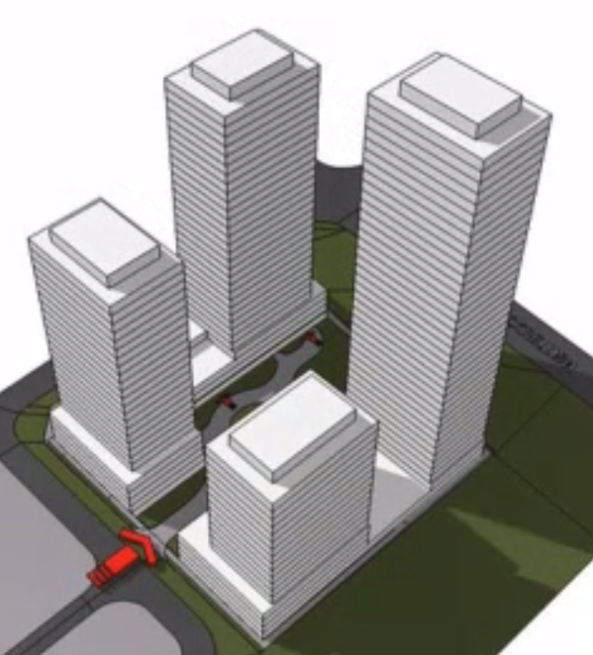 Four towers with some green space in the middle. Height will run from 18 to 39 storeys. 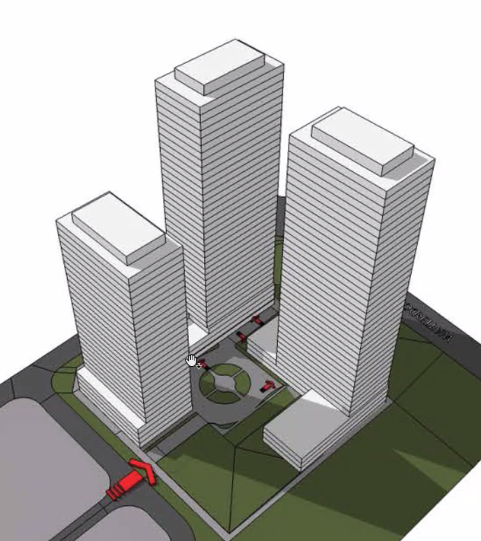 Three towers with small park space in one corner. One tower at 29 storeys two at 39 storeys. The three tower option was made up of one 29 storey tower and two 39 storey towers.
The four tower option had buildings ranging from 39 storeys to 18 storeys.
There will be additional opportunities for public input. The truth is that there isn’t a community in place yet – there is no one to speak for the development and what it offers for those who see it as a place to live.
It is reasonably priced – said to be in the $700,000 range.
There are no homes in the immediate area that will be severely impacted by the high towers.
The development started when Rick Craven was Councillor for ward 1.
The land was reported to have been purchased from the Paletta interests for $14 million.
The ADI group has in the past built quality housing with some very innovative design.
Their Nautique in the downtown core is a smart looking 26 storey structure that has broken ground.
Getting to the point where they were able to start building meant breaking a lot of the rules; put another way – they were able to convince the then OMB that the little bus station on John Street was an MTSA – a transit area and that justified the height they were asking for.
The ADI’s are tough, very in your face developers. They don’t take prisoners – but they are in the process of creating a community that lacks severely in the way of amenities.

 By Michele Bogle By Michele Bogle
October 5, 2020
BURLINGTON, ONTARIO
The Taste of Burlington 2020 launches today with 35 of your favourite participating restaurants offering their best under circumstances that are far from normal.
An event that started in 2008 with just 12 restaurants taking part has steadily grown.
The event starts Monday October 5th and runs through to the 25th.
This fall, each participating restaurant is again offering mouth-watering pre-fixe menus with appeal for anyone’s palate.
Taste of Burlington has made ordering easier, with extra perks.
Sign up for the ‘free’ Taste of Burlington Passport to view menus on-line. The more times you dine out, using the app, the more chance you have of winning the weekly gift card give-away, or the grand prize of $500 to a restaurant of choice.
Some participating restaurants have special offers for returning. Tallying of the contest used to be by ballot-box, but can now be done digitally.
Kelly Harris, Marketing Specialist with Tourism Burlington and Co-ordinator of Taste of Burlington writes, “Quite excited about this as especially with the pandemic, the ballots don’t have to touch so many hands.”
But wait!, there’s more. If you choose to dine in at any of the participating restaurants, the app allows you to order from the pre-fixe menu without touching anything but your own device.
Dining out at a new or favourite restaurant, has been made easier, safer and more economical with the Taste of Burlington Passport App.
As a cost-saving measure to the restaurateurs, if dining out, there is only pickup available. No delivery. The app also allows you to choose the patio, takeout, or dine in. As well it can be used to make reservations, required for this dining event.
Within this link to the list of participating restaurants, you’ll find the quick and easy application for the passport, if you don’t already have it.
Check each restaurant’s website for dates and times available. Not all locations have their own parking, so leave enough time to find city parking, if dining in.
When dining in, as a patron you can expect the Public Health Guidelines as set out by Halton Region to be rigorously observed.
As an on-going series, I’ll be reviewing some of the participating restaurants to assess, not only the value and quality of the pre-fixe menus offered, but of the safety measures exercised by those restaurateurs.
 Michele Bogle is a Burlington resident who writes for the Gazette on community issues. Ms Bogle has taken part in the Food Network for the second year in a row to audition for the ‘Great Chocolate Showdown’ 2020 and 2021. She made it to the second stage of auditions for ‘Wall of Chefs’ 2019 and finished top 1% of auditions last year for ‘The Great Canadian Baking Show’. Michele Bogle is a Burlington resident who writes for the Gazette on community issues. Ms Bogle has taken part in the Food Network for the second year in a row to audition for the ‘Great Chocolate Showdown’ 2020 and 2021. She made it to the second stage of auditions for ‘Wall of Chefs’ 2019 and finished top 1% of auditions last year for ‘The Great Canadian Baking Show’.

October 4th, 2020
Last week Council endorsed the recommendations from the Planning department on the Scoped Review of the Downtown Core portion of the adopted but not approved Official Plan.
The endorsement goes to Council this week and, if approved, will be come part of the Official Plan that is currently in the process of being revised. It will be sent to the Regional government where it has to be approved.
Citizens created an organization they called We Love Burlington, (WLB). That group released the following statement related to an article the Gazette wrote on the decision of Council to endorse what the planners had brought forward.
The WLB statement should be part of the public record.
Last December and January, WLB delegated before City Council opposing the direction proposed in the returned Official Plan for downtown development and the public waterfront. We were joined in our opposition by our colleague, Gary Scobie, long time civic activist and critic. Today we post a submission by two members of WLB and Gary on the virtually unchanged but ‘final’ direction for downtown and the waterfront. We continue to advocate for local voice and respectfully request that it be heard. If you agree, contact your Councillor and make your voice count. We strongly suggest looking carefully at the morass of documents and not simply the consultant’s Guidelines nor the summaries provided by the City or council members.
September 21, 2020
The following is the joint submission of Lynn Crosby and Blair Smith, two founding members of WeLoveBurlington, and Gary Scobie, long-time civic activist and advocate. We share a common passion for the City of Burlington and a common purpose in protecting its downtown and waterfront from inappropriate development and excessive intensification. We also have a compelling interest in preserving the integrity of local government – that level of governance closest to the citizen and most sensitive to local needs and voice. Indeed, WLB actually was created by the need to counter the provincial direction for amalgamation at the regional government level. The campaign, waged in concert by a number of ad hoc organizations, was ultimately successful and the threat of amalgamation in Halton removed.
Ironically, the government that WLB fought to preserve because of its perceived sympathy to the people’s will, then turned a virtual deaf ear to many of those citizens when it developed its revised plans for Burlington’s downtown. It would appear that proximity to the people is no guarantee of either the ability to hear their voice or follow their wishes.
On December 5th, 2019 and January 12th, 2020, we delegated before Council. On those occasions we questioned the timing and basic process of the course that brought forward the 243-page Integrated Control By-Law Land Use report and the highly interdependent 319-page Preliminary Preferred Concept Report. We challenged the timing, the conclusions and the basic sequencing of events. At that time, we urged Council to address the relocation of the Urban Growth Centre (UGC) and the mis-designation of the John Street bus station and the downtown as a Major Transit Station Area (MTSA). We argued that these actions must be a priority before any acceptable redesign of the downtown was possible. We asked for ‘no more tall buildings’. And we were not heard. Indeed, with our final delegations there was not one question posed. We raised inconvenient truths and there was no will to exchange ideas, no appetite to debate. We were politely but conclusively dismissed. We determined at that time that further delegation was pointless and the course for downtown irrevocably charted.
Today, however, we are making another statement in response to the latest documents, the Placemaking and Urban Design Guidelines and the Downtown Burlington Fiscal Impact Analysis and the latest, and apparently final, version of Report PL-16-20, Taking a Closer Look at the Downtown Recommended Modifications to the OP. We do this to bring orderly closure to our advocacy and, once again, echo the voice of Burlington citizens who deserve to be but have not been heard. Sadly, the situation remains almost exactly the same as it was nine months ago – all this time spent tinkering with the documents, but not substantially changing the position or the “vision.”
On page 8 of the Guidelines, for example, the two designations that enable both the Province and the development community to force high intensity massing of people and/or jobs in Burlington’s downtown remain unchanged and in force. We refer, of course, to the Urban Growth Centre (UGC) and the Major Transit Station Area (MTSA). COB recently announced that Council voted unanimously on August 24, 2020 to request removal of these designations, yet they remain the key component of the downtown OP, the Guidelines, all Schedules and the Fiscal Impact Analysis. Coupled with this is the fact that LPAT, the ‘new’ dispute forum, is a high-rise developer’s dream tribunal where height and massing in designated growth areas are not just supported but are actively encouraged.
The Urban Growth Centre (UGC) designation was first applied to our Downtown through the Places to Grow provincial legislation in 2005 and ratified by Burlington Council in fall 2006, just weeks before the City Election. It demanded a minimum 200 people/jobs per hectare over the area bounded by the Growth Centre and remains in place today.
The Major Transit Station Area designation arrived much later in the second decade of this century through the provincial agency, Metrolinx, based on the unsubstantiated claim that our Downtown Bus Terminal qualified as a Mobility Hub. The MTSA covers roughly the same area as the UGC and requires the same intensification minimums. Both designations support high intensity massing of people/jobs (and buildings) in the Downtown area and reinforce each other as provincial intensification tools. Moreover, both designations share three critical aspects detrimental to the popular “vision” of what constitutes “good planning” for Burlington’s downtown:
The intensification applies over an area, not a building.
There is no maximum stated. Only a minimum is demanded, and municipalities are “encouraged” to go above the minimum.
There is no mention in the legislation of maximum building height – the sky is quite literally the limit.
So, the two most damaging factors remain unchanged and will be ‘in force’ and operative for the foreseeable future – at minimum, until the Regional Official Plan is revised and approved. This factor alone undermines the comforting assurances and lofty principles of the Guidelines. Indeed, the latter are almost a misdirection, intended to appease a skeptical and fatigued citizenry; false guarantees that intensification can be controlled and made amenable to the public will. But, as Guidelines, they exist simply to articulate what “should be” not what “must be” and they can be contravened by any number of higher policies and direction statements. For example, the “Core Commitment: Downtown Vision and Action Plan” (as amended) goes beyond and takes precedence over the “Placemaking and Urban Design Guidelines”.
In essence, the Guidelines are unenforceable, part of an array of reports and documentation that requires a very informed and patient reader to do all the necessary cross-referencing to determine the complete context. As with the past process of last December and January, the documents are too numerous, too dense, too intricate and too complex. They are not intended to easily inform.
Truly, the devil can be in the details. There are instances in which the Guidelines don’t match or conform to the main OP report. One of the best examples is Village Square. The Guidelines talk about 4 storeys “abutting Martha Street” but Village Square, as popularly known, does not extend to Martha Street.
The Guidelines state:
“1. The maximum height of developments abutting Martha Street shall be 4 storeys and/or shall provide a built form transition to Martha Street and north of Pine Street to maintain the existing low-rise character.”
2. Retail frontages should be designed to complement and reinforce the unique human scaled and historic character of the Village Square Precinct.
3. Retail provided at-grade along Pine Street will act as a transaction to the Village Square development and emphasize an intimate relationship with the public realm by providing a minimum setback of 4 metres from the curb.
4. Development should maintain and enhance views of the Village Square.”
The language is intended to give the impression that the low-rise nature of the area is being protected and preserved. However, when the map (notably, only included in the revised schedules and omitted from the Guidelines) is referenced, it is clear that the north portion of Village Square allows 11 storeys. Moreover, both the Report and the Guidelines are silent on the treatment of the Square’s interior. At best this is misleading; at worst, a deliberate omission. And this is characteristic of the Guidelines as a whole. They contain a treasure trove of vague, ambiguous, qualitative language that provides a sense of affirmation but does not allow for measurement or objective validation.
The Guidelines perpetuate a number of known problems and deficiencies already cited with the planning process and the downtown modifications made to the Official Plan. Most glaring, perhaps, is the fact that the Old Lakeshore Road precinct continues to be ignored. Why is this most critical of precincts, the gateway to the downtown, continually out of scope?
Why are the serious issues, constraints and challenges posed not openly addressed? Why reference it as one of the 10 precincts and note that the downtown is “on a beautiful waterfront setting”, then completely ignore what is required to protect the waterfront, enhance its accessibility to the public and maintain the existing views? Indeed, Burlington has had a very uneven record over the last 20 years in terms of preserving and protecting the natural asset of the waterfront. It sold valuable waterfront property to private owners, failed to extend the waterfront trail and allowed development interests to prevail over those of public access. These Guidelines and this Official Plan do little to reverse the mistakes of the past. World class cities provide strict and enforceable measures to ensure that their waterfronts are valued as irreplaceable jewels and true public assets. Burlington, by contrast, posits a “feel good” set of principles (pp 44/45) factored around the discretionary preservation of “views” and “access”.
The same principles with the same poor expectation of effective implementation are used to preserve sight lines to landmark buildings such as City Hall, Knox Presbyterian Church and Village Square. One can reasonably argue that the view of City Hall will be obstructed by the Twin Towers approved for the northeast and southeast corners of Brant and James. Knox is located in the Downtown East Precinct that allows tall buildings and is vulnerable to demolition. Village Square presents a series of already identified issues. In fact, we take serious issue with the whole Downtown East Precinct in which the “precedent” of existing tall buildings is used to justify an ongoing ‘tall building’ development pattern. Why is the “precedent” not anchored in the many one or two storey houses in the area? How does the allowance for 17 storeys on Elizabeth Street and 17 at the Lions Club Park conform to the existing adjacent neighbourhoods? How does it conform to that which the people have been asking and how is it feasible that that small area around tiny Martha Street and Lakeshore/James could possibly accommodate this many tall buildings and additional congestion? Where is the requirement that Carriage Gate finally, after more than a decade, build their promised parking garage and medical centre at the site of their 17-storey condo building atop a three storey “podium” (the much-touted retail portion on ground level still completely vacant) located in the East Precinct? Why is the consultant/staff recommending 22 storeys at the Carriage Gate property at Pearl and Lakeshore, beside the uniformly unwanted ADI property next door?
There is almost a complete lack of green space and amenities. The map in Schedule 3, Appendix D shows three green circles denoting “public parks” (viz. Ghent/Brant, No Frills parking lot and Martha near New Street). They are small, located in insignificant areas and appear as afterthoughts – not integral components of the plan. The City claims to want to create complete communities with all of the amenities, but this worthy goal appears to have been abandoned in the downtown. Indeed, there is no section in the Guidelines dealing with green spaces and parks. Instead of needed amenities, community hubs and actual parkland, we are presented with the concept of POPS (Privately Owned Publicly Accessible Spaces) as leisure and recreational areas for the thousands of people who will populate the new buildings. The POPS were featured in the Fall 2019/Winter 2020 presentations of the preferred concepts for downtown. They were not critically acclaimed then and deserve no better treatment now. In fact, little has changed with either the concepts or the consultant’s treatment of the design for downtown. So, for example, where is the recognition that the pandemic has dramatically changed our reality? In the Fiscal Impact Analysis:
“Table 3-1 summarizes the residential growth projections for Downtown Burlington to 2031. It is anticipated that the within Downtown Burlington, the City’s population will grow by 2,787 population over the 2020-2031 forecast period. The population growth will be facilitated by the development of 1,720 additional high-density residential dwelling units. Consistent with the assumptions of the 2016 FIS, it is assumed that 75% of high-density residential development will be in the form of condominium development, with the remaining 25% comprising apartment developments.”
Remarkably, there is no updated view of the changes that COVID has made to our lives and the nature of our future living. Today, and for the foreseeable future, there is far less desire for condominium living and cloistered spaces. People want to distance and separate, want more open spaces and houses with traditional features and backyards. Accordingly, there should be fewer allowances for tall buildings and much better-defined planning for open spaces. Why is the consultant’s vision unchanged?
This speaks to our final major issue – the implicit cynicism of the consultation process and the lack of meaningful public engagement. Much has been made by the City and Council in ward newsletters and social media posts of the extensive outreach that has been undertaken. Citizens have been thanked for their time and effort reviewing an endless array of documents, helping to make the Official Plan and its policies a better, more inclusive work. However, nothing has materially changed. The preferred concepts, the vision and principles, the Official Plan itself with its myriad ancillary reports and the strategic documents ‘ad infinitum’ have not been varied or amended. The direction has not been moderated by either public comment and feedback or influenced by a differing public perception. The development scenario was essentially set during last Summer and Fall, when SGL Consulting was engaged under a directed tender to validate staff-defined outcomes. The necessary substantiating reports and studies were then concluded with predictable findings and the path forward unaltered from that framed and established at the very beginning.
Neither Council nor Planning staff should believe that a lack of new comments opposing much of these final documents means that the public now finds them acceptable. In the midst of a pandemic and at the end of a very long, quite protracted and overly tiresome process with too many documents, too many cross-references and too many versions, people are fatigued with the need for repetition; for saying repeatedly what they want and never being heard. We know that the council members are there to speak up on our behalf, convey our long-standing and unchanged positions, and to direct staff as they see fit. This is what the public expects and is counting on.
In summary, we’ve been here before – several times actually and nothing substantive has changed. It’s not that we expect that Council is under any obligation to passively comply simply because we attended and delegated. However, we did expect to be respected and to be heard. We represent a popular voice to which you have turned a deaf ear; worse, to which you have claimed an avid attention, then done nothing. We respectfully request that you provide for substantive amendments to the Official Plan, addressing the deficiencies noted in this submission and reflecting what the people of Burlington want for their downtown.
We understand that Council has worked with staff on modifications to produce a revised Official Plan for endorsement but we believe that it is seriously flawed. It leaves the waterfront vulnerable to development and permits a downtown in which tall buildings will dominate, with no real green space or public amenities. As we have said from the beginning, there is only one waterfront and one downtown – once gone there will be no bringing anything back and we urge the current Council, elected with such high popular expectation two years ago, to do everything needed to clearly ensure their permanent protection. Your legacy depends on it.

 By Pepper Parr By Pepper Parr
October 2nd, 2020
BURLINGTON, ON
This story goes back to 2015. At the time there was a Memorandum of Understanding between the city and BSCI expired on Dec. 15, 2015.
The City of Burlington had taken over all operations at the Burlington Seniors’ Centre after severing ties with an independent board of directors that had been responsible for running some aspects of the city-owned facility.
The city ended its association with Burlington Seniors’ Centre Inc. (BSCI) at the start of November following a recent decision not to renew its partnership agreement with BSCI.
Under the previous agreement, BSCI had the responsibility at the centre for running the Bistro Café and annually organizing seven day trips as well as one lunch and Christmas dinner and a Robbie Burns dinner.
On Oct. 26, the city notified BSCI that it would assume these responsibilities as of Nov. 1, said Fred Hendriks, president of BSCI, a non-profit volunteer entity that was incorporated in 2012.
 Kwab Ako-Adjei, Director of government relations and strategic communications for the City of Burlington. “From a service delivery perspective, we had two different entities offering services to members. … the BSCI operated the bistro and organized the day trips while the city organized everything else,” said Kwab Ako-Adjei, senior manager of government relations and strategic communications for the City of Burlington.
“The recent change means that we now are able to offer the same training, support and recognition to the volunteers in the bistro and events areas, who were formally the only volunteers not under city supervision.
“…. This conclusion in our relationship (with BSCI) will have no operational impact on service to the 3,800 members of the seniors’ centre. All the programming members have come to enjoy will remain the same.”
The paid chef who manages the bistro will remain in his position, said Ako-Adjei, who added that, if anything, he expects some service improvements and enhancements at the centre in the future, but didn’t elaborate.
Hendriks said his board members had expected to have meaningful dialogue with city representatives about a renewed working arrangement and feels that didn’t happen.
“The city and BSCI have been in discussion for many months about beginning negotiations to renew the MOU. BSCI is disappointed that the city chose to end the relationship in this premature and disappointing manner without any BSCI consultation.”
Ako-Adjei disagreed with Hendriks’ assessment.
“Since October 2015, the BSCI and the city had co-cooperatively agreed to work though a mediation process facilitated by an external facilitator, which amongst one of the objectives sought (was) to clarify roles and responsibilities at the seniors’ centre.
“At the conclusion of this lengthy and thorough mediation process, the outcome highlighted our collective inability to effectively move forward as partners…. As with any end to a relationship, the decision was not an easy one to make…”
BSCI is now operating as Burlington Seniors’ Community (BSC) and is governed by the same board of directors, said Hendriks.
It has a boardroom within another local organization’s building and will hold meetings there, he noted.
“The BSCI board will meet in November to discuss next steps. Our goal is to continue to be a vital organization supporting the well being of Burlington’s diverse and growing community of seniors,” said Hendriks.
“…. BSCI hopes to offer our experience and expertise by collaborating with BSAC (Burlington Seniors Advisory Committee) and other seniors groups throughout the community.”
As for wrapping up its affiliation with the city, Hendriks noted that programming staff in the city’s recreation department are responsible for all programs at the seniors’ centre.
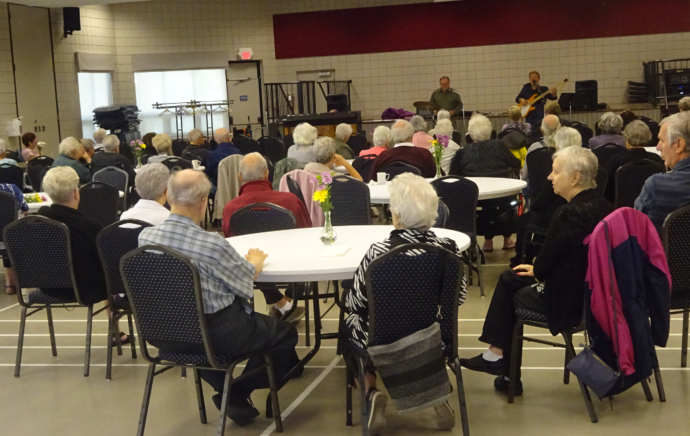 Music programs are part of the program offering at the Seniors’ Centre The city hires and pays the centre’s program instructors and determines the content.
All seniors’ centre membership fees his group received as BSCI were forwarded to and managed by the city, he said.
However, BSCI did receive and manage money donated directly to it by independent groups like The Boutique Ladies, which sold handmade items and donated proceeds to BSCI, and Club Nine.
“All of those generous donations were given to BSCI to be used at the discretion of BSCI’s board of directors. The board of directors chose, instead of using such donations for operating expenses, to add all of them to profits from running the bistro, day trips and events,” said Hendriks.
He said the BSCI used these funds to purchase items that would benefit the members of the Burlington Seniors’ Centre, things like playing card tables, dirty dish carts, a fridge, freezer and utensils.
As well, the BSCI had given tokens of appreciation to the centre’s volunteers such as free coffee, food vouchers for the bistro or Tim Horton’s cards.
Hendriks wouldn’t say how much money is in the fund managed by BSCI/BSC, just that those funds “will continue to be used to further the interests of seniors in Burlington”.
“No decisions will be made about those funds without thoughtful deliberation, transparency and input from the local seniors’ community.”
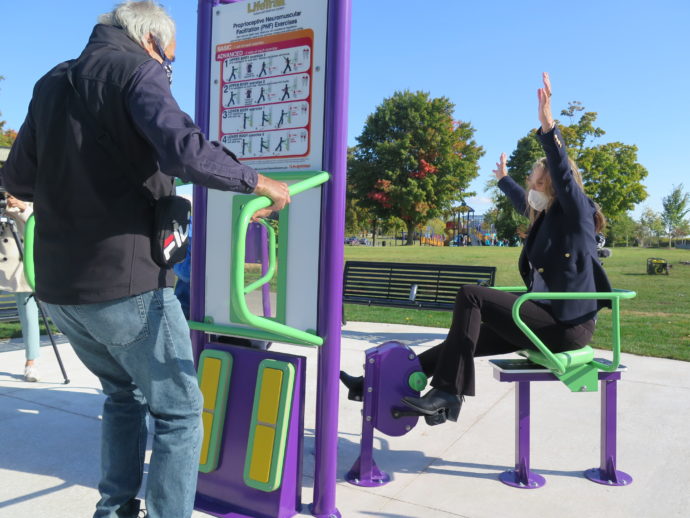 Mayor Meed Ward on the right and Regional Chair Gary Carr on the left at the unveiling of the exercise equipment at Burloak Park. Fast forward five years and we have the Mayor, the Regional Chair, a couple of members of council unveiling a plaque that says the equipment in the Burloak Park was purchased by the Burlington Seniors Centre, a not for profit private group that once used to run programs at the Centre and operated a very profitable Bistro.
When the city parted ways with the group they took the money they had (it was a substantial amount) and used it for events that benefited the senior community.
The exercise equipment was their most recent initiative. Finding a place to put the equipment turned out to be a real challenge. The city provided little in the way of help. They were eventually able to find a space in the Burloak Park. The preferred site was somewhere in Central Park.
The working relationship between Parks and Recreation and the seniors group was never healthy.
When things were difficult back in 2013 the seniors decided their issues would get attention if they went after members of Council – that tactic worked.
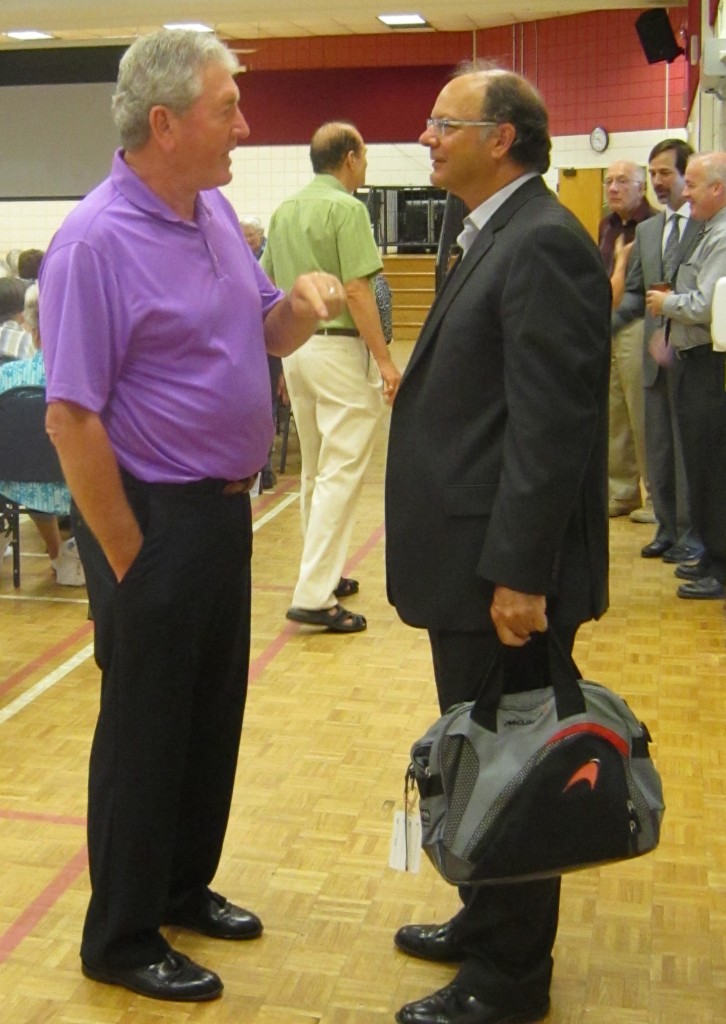 City manager Jeff Fielding with Joe Lamb, negotiating for the Seniors’ Centre Jeff Fielding was the city manager at the time; he was a delight to work with as far as the seniors were concerned. The problems were worked out.
When James Ridge became city manager a lot of things changed.
The Seniors’ Centre is administered by the Parks and Recreation department which many feel has never really understood what the seniors want and need in terms of recreation and exercise needs.
The Gazette recalls an occasion when ward 2 Councillor Marianne Meed Ward took part in a “listening” exercise. She met with anyone who wanted to take part in a gathering of people at the Centre to talk about the issues. It was a somewhat muted occasion when members found that staff were lined up at the back of the room listening carefully. Members felt intimidated and not prepared to speak out.
Parks and Recreation has not been able to find people who can empathize with the seniors, understand their concerns and put up with some of their limitations.
This isn’t the story that got told out at Burloak Park Thursday morning.

 By George Wolfson By George Wolfson
September 30th, 2020
BURLINGTON, ON
The majority of gambling platforms allow users to play both for real money and free games. However, the winnings can be obtained only when playing for real money (with the possibility of their further withdrawal to a card or online wallet).
 The majority of gambling platforms allow users to play both for real money and free games. To increase your chances of receiving such a prize, it is worth listening to helpful advice from experienced professionals. If you are just starting your way in gambling, then you should pay attention to the no deposit bonus and the conditions to win without investing your money.
What Is No Deposit Bonus?
This reward is one of the casino promos that provides players with cash when they open an account or try a new game without replenishing it. In fact, there are not too many places where you can get real money with no deposit So, these bonuses offer a great opportunity to try a new casino or new game with minimal risk.
Gambling platforms may offer two types of such rewards:
1. Cashable: they allow the player to withdraw both the bonus money provided and the winnings;
2. Non-cashable: they cannot be withdrawn, because the casino deducts it from the total winnings.
The main purpose of such gifts is to advertise the brand, as well as quickly increase a client base. Usually, gambling platforms use no deposit bonuses in order to attract new customers or reward regular players.
 Understand the pros and cons of using no deposit bonus gambling – then have fun. Thanks to this offer, players can try something new without risking their own money. Online casinos can also provide free rewards on any new game so that visitors can play it and only then replenish the account.
Pros and Cons of Using No Deposit Bonuses
It should be noted that everything has its positive and negative sides, and all types of free rewards as well. So let’s pay attention to the pros and cons of using no deposit bonuses:
Advantages:
1. Having used these rewards, you will be able to study the whole functionality of the site and make sure that it is worth your trust;
2. You will be able to test the game in the real money mode and understand the principle of its work;
3. The player does not spend his own money and, as a result, he does not have to invest his own funds, if something is wrong with a casino.
Disadvantages:
● Small size. If you think that casinos are giving hundreds of dollars, then you are wrong. Usually, the reward starts from $10-20 free dollars to several dozens of free spins;
● The original bonus will not be allowed to withdraw immediately after the receipt. The withdrawal option appears only after playing a wager;
● These rewards are issued for a small number of games. As a rule, the use of free spins is limited to one or a few video slots.
Having considered the pros and cons of using no deposit bonus, you are ready to start. Good luck!

 By Pepper Parr By Pepper Parr
September 26th, 2020
BURLINGTON, ON
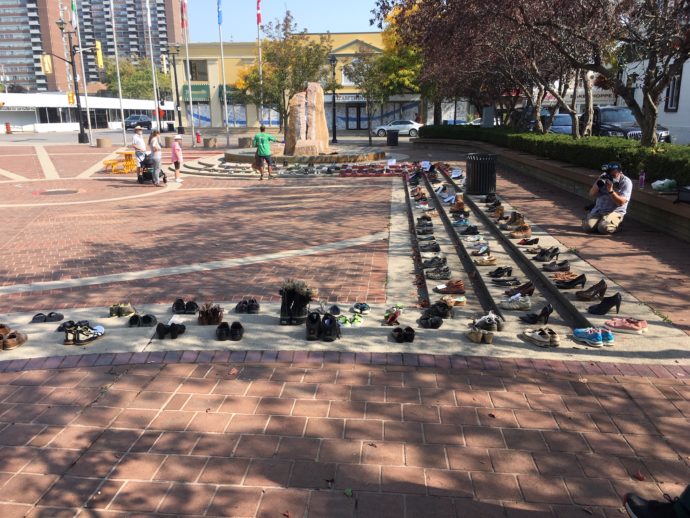 A silent protest. There they were.
Set out ever so neatly within Civic Square – more than 230 pairs of shoes.
They were part of a silent protest about what we are not doing about climate change.
It was billed as a climate strike inviting everyone in Burlington to join in demanding that all levels of government act immediately on the urgent climate crisis.
The social distancing rules had to be respected. How do you do that?
The people who organized the event identified two places where the shoes could be dropped off. The Rolling Horse Community Cycle in Aldershot and a private home in Millcroft.
Participants were invited to insert a note inside their shoes to convey their message about why urgent action on climate change is important to them.
This was a silent protest. There were no opportunities for speeches or public announcements or political leader photo ops.
After the silent protest the shoes were collected and returned to hosts or donated to a local charity that will distribute them to those in need.
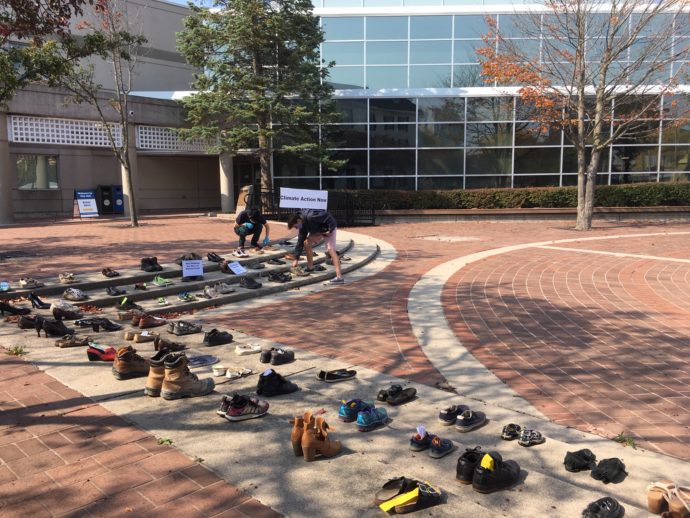 Many of the shoes had notes in them – setting out the wish, hope, aspirations and dreams of those who had walked in those shoes earlier. Similar Shoe Strikes were to take in Oakville, Milton and Halton Hills; those situations didn’t work out very well.
Oakville found that their plans were upset with the COVID-19 rules on how many people could gather in a group.
Milton ran into bureaucratic problems – the need for a permit and the need for insurance.
Fridays for Future will be co-coordinating similar Climate Strikes throughout Canada. Locally, organizers come from a cross-section of groups: Burlington Biodiversity Team, Students for Change Halton, BurlingtonGreen Youth Network, Burlington Citizens Concerned about Climate Change (BC4), and local residents.

 By Pepper Parr By Pepper Parr
September 22nd, 2020
BURLINGTON, ON
PART 2 of a SERIES: The first piece in this series of articles on the incredible success the citizens living in the Appleby Village part of the city had when they went up against a developer who had filed an appeal with the Local Planning Act Tribunal (LPAT) .
The first the larger public heard about how things had turned out for the citizens who were opposed to the Appleby Village development was when the Mayor announced during a Council meeting that there was a settlement offer from the developer.
The development project in the east end goes back to 2014 – the developer had a plan that got put on hold when the Region realized that the Storm Water System could not handle the amount of flood waters; that a larger pipe would have to be put in place.
That put the project on hold for two years.
Jeremy Skinner, an east end resident who spends his free time going to community meetings, had become friendly with Ward 5 Councillor Paul Sharman and got into the habit of attending his meetings.
Skinner wondered if there were people in the community who were as curious as he was about how such a development would get past the Planning Department.
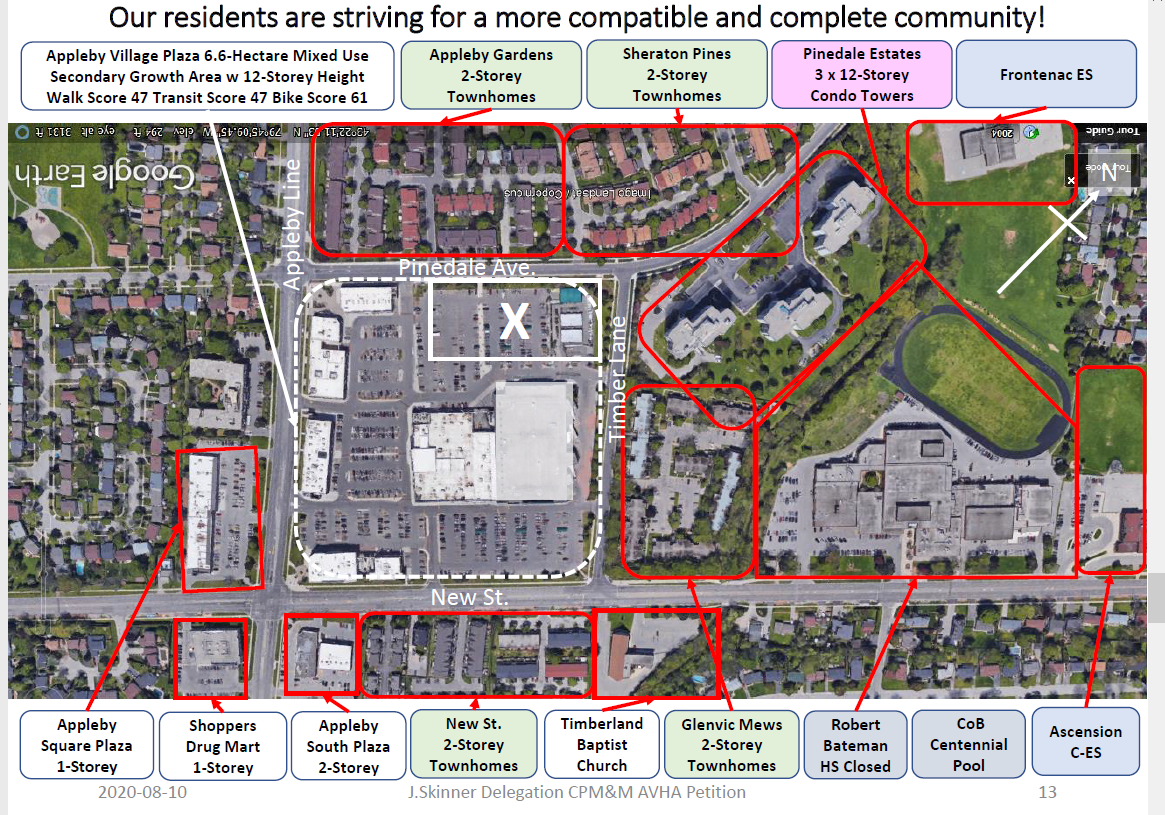 There is a very vibrant community surrounding the site. The area in the center in grey is the land that has undergone significant re-development during the past ten years. The X is where the high rise and town houses are going to be located. The Gazette had been following the story but not as closely as Skinner.
Skinner put together a flyer and dropped them off at homes in the immediate area of the proposed development which at that time was for two Residential Condominium Apartment Towers with one at 12-storeys and the second at 17-storeys. These were subsequently changed to 17-storeys for both towers when the matter got to an appeal application.
The residents who bordered the proposed development of Appleby Village were shocked to receive invitations to attend the initial LPAT Pre-hearing Conference for the First Capital (Appleby) Realty appeal for lack of City decision to amendments to the Official Plan (OP) and the By-law (ZBL). They got the invitation either because their homes were within a boundary set out by the city or because they had attended a meeting and put their names on a sign up sheet.
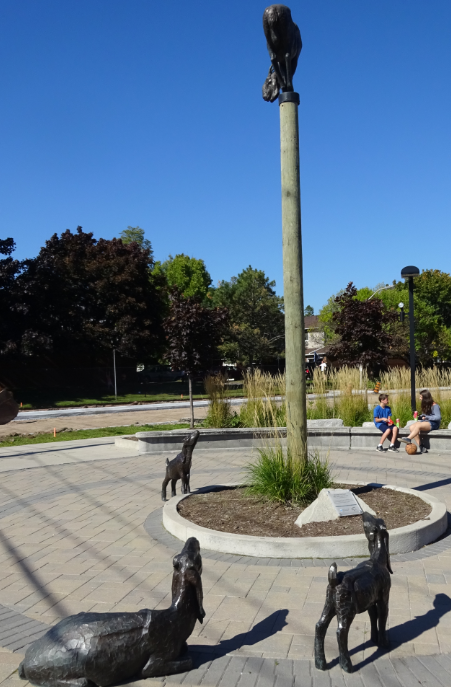 Public art is set at the north west corner of the Village. Goats. The Official Plan (OP) and the Zoning Bylaw ( ZBL) for the 6.6-hectare site were defined as a maximum of 12-stories.
Nothing was happening while the Region improved the storm water pipes. That work was completed by the end of 2016.
At about the same time there were rumblings within the development community that the Ontario Municipal Board was going to undergo a significant change. Word at the time was that municipalities were going to have more involvement in the process – that belief supported by the new name. Local Planning Act Tribunal. The LPAT acronym turned out to be very misleading.
The new act came into effect on December 12th. Many developers, believing they could read the tea leaves, filed appeals wanting to be heard under the old OMB rules. First Capital filed their appeal on November 17th, 2017 which meant their appeal would be held under the to-be-replaced OMB rules and procedures. It also meant that the city’s Planning Department was out of the game – the city lawyers now had the file.
By this time Skinner had become quite active in the community and recruited what he called “street captains” people who would distribute another flyer to households.
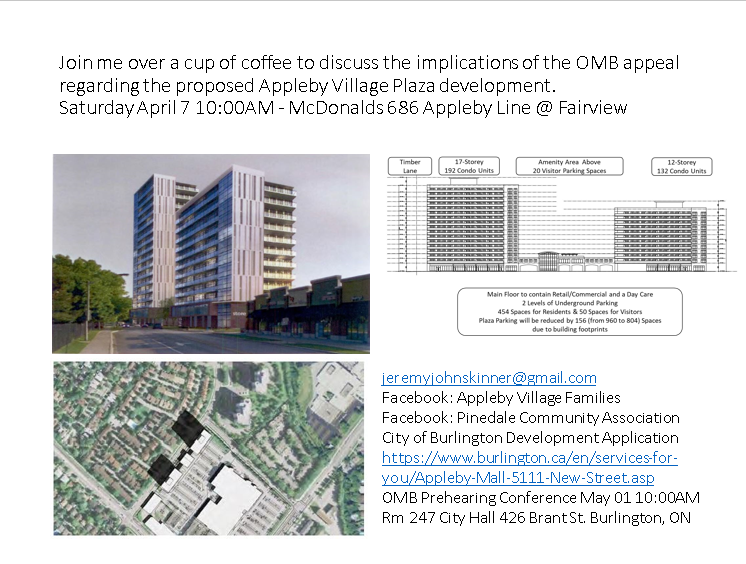 The invitation Jeremy Skinner distributed to the neighbourhood. Sixteen people took up the invitation – Skinner now had his community group.
They met on a number of occasions figuring out what their approach should be and what was actually possible. They knew the development wasn’t going to be taken off the table – but believed they could get changes that made it better for everyone in the community.
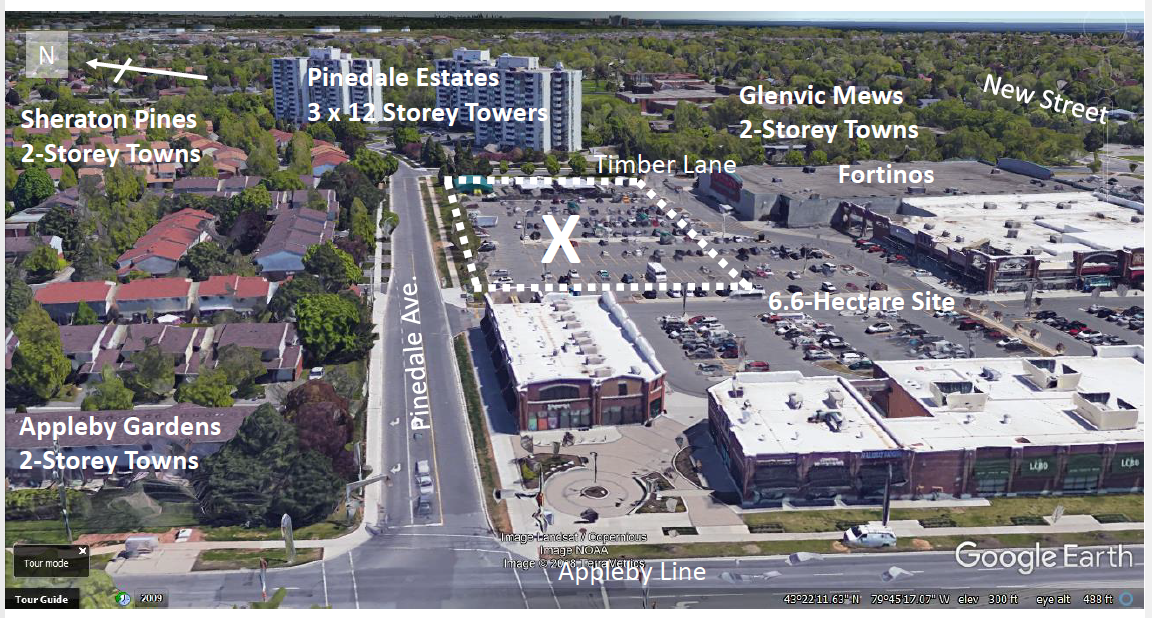 It’s an active site with a very good restaurant, a Starbucks, an LCBO, a bank and a supermarket. The first LPAT appeal meeting took place at city hall on May 1st where those seeking Registered Participant status were advised to group themselves with other residents who had common concerns and identify representative speakers who would make statements at the hearing.
That was initiative enough for Skinner to host a neighbourhood meeting on the 26th of June 2018 at Pineland Baptist Church. “At the meeting, we reviewed what was known about the development application, and then considered our response based upon what we believed was possible to win at LPAT and what would be required to do so.
“We decided not to challenge the Developer or the City on matters such as: the number of buildings; building heights; number of residential suites; the number of their guests’ vehicles in underground parking; and impact on traffic for the developer and the City to resolve” said Skinner.
“This was due to the high costs to hire LPAT recognized Subject Matter Experts and suitable Legal representation. Instead, we decided to focus our efforts on documenting our issues of “transition compatibility to our bordering residential neighbourhood properties” and the need to “improve and make safe pedestrian egress to the site”.
“We drafted and ratified a proposal letter complete with eight conditions summarized below which, if satisfied, would result in the community group withdrawing our objection to the proposed development and instead to follow the City’s lead. It was sent to all LPAT parties and the LPAT Case Coordinator on the 8th of July 2018.
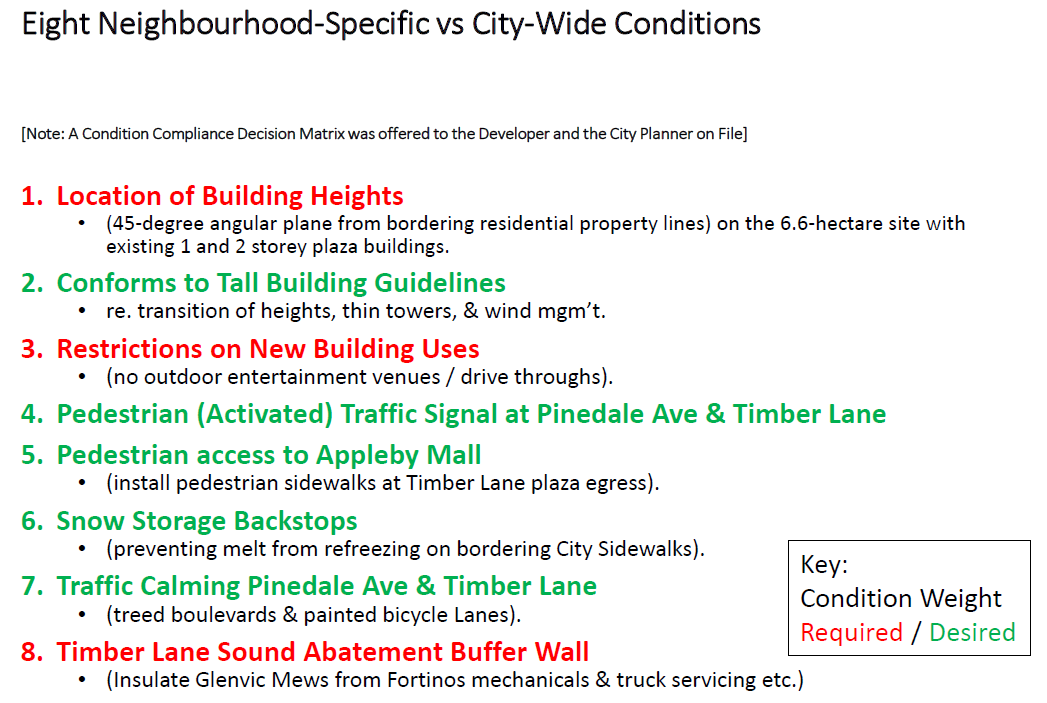 These were the conditions the community took to the developer.
There were numerous meetings with the developer’s architect and senior people at First Capital. The residents knew that the development was eventually going to get approved and that they really didn’t have much clout; the developer wanted to get on with the construction and move the file forward – getting rid of the residents was the price they would have to pay.
At a subsequent LPAT meeting (Preconference Hearing # 2 ) Eileen Costello, a lawyer,with Aird and Berlis, counsel for the developer, advised LPAT that on the 30th of October, 2020 they would be submitting a revised development plan that was being submitted on a Without Prejudice basis and that “discussions have continued with the City”.
Ms. Costello stated that they have looked at the information submitted by the local residents and intend in the future to take a revised proposal out for communication and discussion with the residents.”
What this meant was that the residents had prevailed – the developer was going to go along with much of what the residents had proposed.
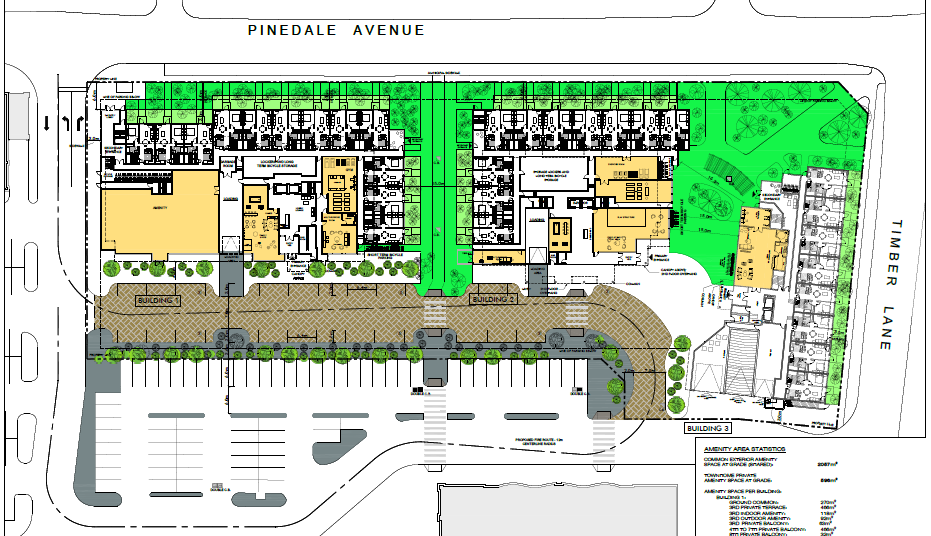 Green = development pedestrian egress & townhouse front yards Now the challenge was to make that point with the city and to get the Planning Department back into the game. They were no longer part of what was happening – the moment the developer filed the LPAT appeal the city’s legal department was in control of the file – not that the city had all that much going for their side of the difference of opinion on the development.
Jeremy Skinner delegated at city hall on a matter that was part of the CLOSED SESSION agenda.
He started out telling the Council members that the day before there had been a ZOOM meeting that his group had been invited to attend. The developer set out the changes they had made.
Those changes were enough for the Appleby Village community group to withdraw their objections.
In a short report on the city web site the scope of the win for the residents is set out:
The settlement between the City and First Capital resolves the issues in dispute between the City and First Capital on the basis that First Capital and the City will seek LPAT approval of a revised development concept for the property. The City and First Capital will request the LPAT withhold a final order approving the development until the City and First Capital are satisfied with technical studies that are required to support the revised development concept.
The revised development concept proposes 368 dwelling units in both apartment and townhouse forms located on a portion of the site of the former Appleby Mall that currently contains a parking area adjacent to existing retail/commercial uses. The revised development concept reduces the building heights of the original proposal from 12 and 17 storeys, down to a 9 storey and two 12 storey buildings that are in compliance with the Official Plan. The revised development concept also: increases setbacks from Pinedale Avenue; reorients and redesigns the buildings to achieve compliance with the City’s Urban Design Guidelines; introduces townhouse units at the base of the buildings; and provides enhanced landscaping, among other things.
The City and First Capital will attend at the LPAT hearing scheduled to commence on November 2, 2020 to seek approval of the Zoning By-law amendment and revised development concept by the LPAT.
End of part 2
Part 1.

 By Pepper Parr By Pepper Parr
September 22nd, 2020
BURLINGTON, ON
We are going to hear a lot about the 2026 Commonwealth Games and the bid Hamilton is making to have them held in that city.
The original Games were held in Hamilton in 1930 – known then as the British Empire Games.
The Empire no longer exists and if the Games do come to Hamilton for 2026 there is no certainty that there will even be a Commonwealth.
But we digress.
Back in May the Commonwealth Games Federation asked the Hamilton contingent to consider a bid for 2026 because it likely wouldn’t be challenged.
 That got the Hamilton people changing gears and getting really serious – even though the number to pull this off is set at $1.4 BILLION – much of which would come from the federal and provincial levels. That got the Hamilton people changing gears and getting really serious – even though the number to pull this off is set at $1.4 BILLION – much of which would come from the federal and provincial levels.
Mayor Meed Ward is meeting with top level lawyers at Gowlings in Hamilton where she will chat with the Paletta people about how Burlington can be part of the pitch that is being made to get the games to Hamilton for 2026. No word on whether this is to be a virtual meeting or in the Gowling Board room that is big enough to let everyone sit six feet apart.
 Bronte Creek Meadows: Zoned as Employment – would an Olympic Village qualify? The Paletta’s have significant property interests in Burlington – some of which are zoned as Employment Lands – what if there were a Games Village on the Meadows on Upper Middle Road where it turns into Burloak.
Bronte Park is right across the street – can you see the picture that is developing?
The Mayor will be meeting with Louis Frapporti, Managing Partner at Gowlings and a huge believer in all things Hamilton.
It will be interesting to hear what the Mayor has to say at the September 28th City Council meeting.
Now if the Mayor would get into the habit of holding regular media events we could put the question to her.

 By Staff By Staff
September 22, 2020
BURLINGTON, ON
Wrong building, wrong place and miles outside the Official Plan and zoning for the property.
The development was to be located on the west side of Guelph line just south of New Street.
The Staff recommendation was to refuse the application for official plan and zoning by-law amendments submitted by Weston Consulting, on behalf of Valour Capital Inc. for the development of a 13-storey residential building on the property located at 420 Guelph Line.
CARRIED
Council debated this one for more than an hour and urged the developer to do a makeover and perhaps work with an abutting property owner.
The immediate area already has several development applications in the works – five years from now you will probably not recognize the area.
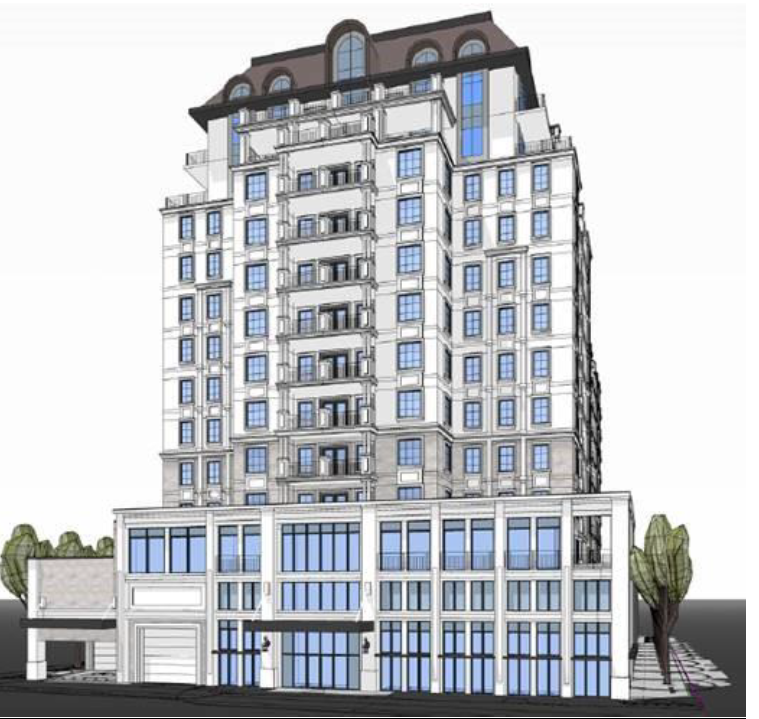 The developer was asking for too much and the neighbours didn’t like it. 
 By Staff By Staff
September 21st, 2020
BURLINGTON, ON
A Shoe Strike
What is a shoe strike.
First it is taking place on Friday September 25th.
Why?
WHAT: A unique youth organized climate strike inviting everyone in Burlington to join in demanding that all levels of government act immediately on the urgent climate crisis.
HOW: Due to social distancing, the climate strike will be held in a representational manner, with the community invited to share a pair of their SHOES to represent their participation. Shoe Strikes have been effective in several locations and countries around the world. Participants are invited to insert a note inside their shoes to convey their message about why urgent action on climate change is important to them. Youth organizers will summarize the notes and relay them to local political leaders.
NOTE: This will be a silent protest. There will be NO opportunity for speeches or public announcements or political leader photo ops.
 Shoes can be dropped off in advance at: Rolling Horse Community Cycle (650 Plains Rd E #2) & 2466 Newport St. (a house near Headon Forest Dr.) beginning on Tuesday, Sept. 22nd & up until Thursday, Sept 24th. Shoes can also be placed at the shoe strike location (tent. scheduled at Civic Square, City Hall, Brant Street) between 10am and noon on Sept. 25. Shoes can be dropped off in advance at: Rolling Horse Community Cycle (650 Plains Rd E #2) & 2466 Newport St. (a house near Headon Forest Dr.) beginning on Tuesday, Sept. 22nd & up until Thursday, Sept 24th. Shoes can also be placed at the shoe strike location (tent. scheduled at Civic Square, City Hall, Brant Street) between 10am and noon on Sept. 25.
WHEN: Friday, Sept. 25 – Shoe drop off from 10am to noon. Silent Shoe Strike display from 12 noon to 2pm. After 2pm shoes will be collected and returned to hosts or donated to a local charity that will distribute them to those in need.
WHO: Similar Shoe Strikes will take place in Oakville, Milton and Halton Hills on the same day, approx. at the same time.
Fridays for Future will be co-ordinating similar Climate Strikes throughout Canada. Locally, organizers come from a cross-section of groups: Burlington Biodiversity Team, Students for Change Halton, BurlingtonGreen Youth Network, Burlington Citizens Concerned about Climate Change (BC4), and local residents.

 By Ray Rivers By Ray Rivers
September 18th, 2020
MOUNTSBERG, ON
These are scary times especially if you are grandparents. When it comes to educating our youth, no one should doubt that school boards, teachers and maintenance staff are doing the best they can in the circumstances. But then nobody can say the schools are as safe as they could be – or used to be before the pandemic hit us. The circumstances have changed.
Seven months have passed since the schools were shut down as part of the provincial COVID-19 lock-down. The Premier warned us that this was not going away, that we’d have to change how we do things if we are to avoid getting infected. So what about the children? Aside from some widening of the aisles between students’ desks very little seems to have changed.
Yes, there are the masks and the single cohorts and the managed crowd control, coming and going. But the students, for the most part, are still captive and crowded within their inadequately ventilated classroom environment for most of their day – another petrie dish for the virus and another opportunity for viral transmission.
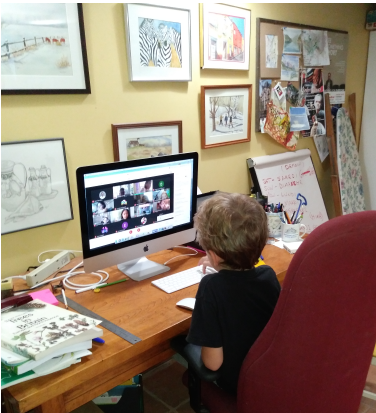 Leo taking part in a class exercise So when my wife and I had heard that school would be returning pretty much business-as-usual, we reached out to the parents of our youngest grandchildren and offered to help with their children’s grade 2 and 4 French immersion schooling. There are in excess of 20,000 children who receive homeschooling every year in Ontario, so we’d be in good company, we thought.
Fortunately the education ministry had announced that parents could opt out of sending their children back to the classroom and engage in their program of online or distance learning instead. Students would pretty much get their regular course load but learn at home rather than trucking off to school. The Halton Board sent out requests to parents asking them to opt for the option of their choice.
Teachers, apparently some also teaching regular classes, would appear online through the application of Google online conferencing tools, mainly Google Meet and Google Classroom. Teachers use various media to assist in their online teaching and students are even invited to submit contributions, such as, photos.
There are three teaching blocks of 100 minutes each covering the 8:45 am to 3:05 pm day, and duplicating the essence of what would be learned in a regular classroom. Students may even be given homework assignments. And the online platform allows students to see their teacher as well a number of fellow students, making the experience feel a little less remote.
When we undertook to invite the children to our house we expected that we would be heavily involved in preparing classes. Both of us do have some pedagogical training. As it turns out our role is little more than supervision and coaching as the teachers do the heavy lifting of bringing the curriculum to life on the small screen.
How is it going? Well there was some minor stumbling at the beginning, something one should expect with the introduction of this new way of conducting regular classroom instruction. But the students appear to be excited about what they are doing. And the teachers, in our experience, have been wonderful, clearly competent, enthusiastic and responsive to the needs of the students and their coaches.
While being able to conduct regular classes online sounds pretty amazing, the truth is the technology is still not as user friendly as it could be. But the biggest problem is the size of the online classes. There are close to thirty students in each of the children’s classes.
 Bea doing math. It is impossible to practically see all of one’s classmates on a computer screen. And so it is a difficult for the teacher to stay on top of what everyone is doing. And that makes it a huge challenge for effective immersion language training, for example.
Going through the roster of students can take an inordinate amount of time and that can be really boring to those waiting their turn. Students can lose interest and drift off, even with the best of teachers. And that is the big fear – that students will lose interest, shut down, and their performance will reflect that failing.
This is the same problem one sees in over overcrowded regular classrooms only magnified by the remote learning complication. The solution is obvious – hire more teachers for distance learning. In a country where the unemployment rate is currently above 10% and governments are spilling money like rain water, you’d think this was more than possible.
Of course teachers need some training and a program to follow but this is not rocket science – unless they actually are teaching rocket science. And of course experience counts. But our children are the future, why wouldn’t we want to invest more in their education?
Distance Learning –
Online Learning –
 Ray Rivers usually writes about politics and the environment. His grandchildren are doing elementary school as distant learners. Ray Rivers usually writes about politics and the environment. His grandchildren are doing elementary school as distant learners.

 By Pepper Parr By Pepper Parr
September 17th, 2020
BURLINGTON, ON
About once a month – there is this tour de force that takes place at a Standing Committee.
Sheila Jones, the former City Auditor, found herself going toe to toe with a member of Council. The Councillor lost.
 Sheila Jones: Executive Director of Strategy, Risk and Accountability. The difference of opinion had to do with just how much information Jones was prepared to release when all hell was breaking loose over the Customer Relation Management software that had gone off the tracks and was badly in need of some resuscitation.
That occasion was the first time we saw the feistiness that is very much a part of the Jones persona. It wasn’t something we saw in her as a shy auditor.
City Manager Tim Commisso was in the process of redesigning his senior management team; every city manager seems to need to do a re-ordering of the Colonels in his army. Jones got chosen in a competition for an Executive Director of Strategy, Risk and Accountability.
Several months before her appointment Jones led Council and Staff in a workshop session on risk and strategy. She acted like a cheerleader – pushing the importance of risk when creating a strategy. That kind of positive push is seldom seen at city hall.
When COVID-19 hit the world Commisso wisely put Jones in a command role. She pulls together the data she needs from throughout the departments – she knows their role, the department strengths and weakness – she used to audit them.
Earlier today she took council through a review of where things stood given the COVID environment – financially, and the status of the work being done by each department.
On occasion she refers (not defers) to Commisso for a comment.
 Sheila Jones, second from the right – went to to toe with a council member – we saw real leadership. In the past couple of months we hear less and less from Commisso. The pace for him has been brutal – it certainly wasn’t what he thought he was taking on when he was asked to serve as the interim city manager when James Ridge was shown the door.
Commisso had worked for the city for a number of years earlier in his municipal career – he knew where all the bones were buried. This was going to be a another layer of income for his retirement years.
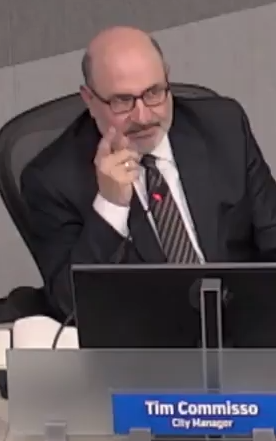 Commisso raising his hand – not something we see very often. He tends to be quiet, laid back and delegates much of the time. Then COVID hit the fan – and his world changed. And he really didn’t have that great a team in place. There was some baggage that he had to pack and ship out. And some of his stronger people had to leave their jobs – behavioral issues.
In his re-design Commisso found this gem – did he know how well Jones would serve?
Hard to tell but there is no denying that she has a firm grip on the wheel and is determining the course much of the time.
Hard to find a negative word about the woman.
The question that comes to mind is this: what is the city going to do when the Commisso contract comes to an end. It won’t (shouldn’t) be extended.
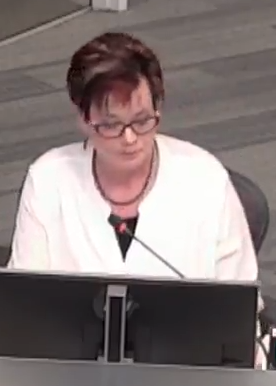 Some much needed energy and positivity from Sheila Jones. Is Sheila Jones a possible next city manager?
Why not – Hamilton has a woman doing the job – and based on what we have seen so far Sheila Jones could (and should) lead.
Would she be able to work with Mayor Meed Ward? Not that many woman find they can work with this Mayor; her very competitive nature and habit of using up all the oxygen in a room makes it difficult at times.
Mayor Meed Ward has other political mountains to climb – Jones could make her look very good allowing the Mayor claim she made it all possible as she moves on to the provincial level.
Salt with Pepper is the musings, reflections and opinions of the publisher of the Burlington Gazette, an online newspaper that was formed in 2010 and is a member of the National Newsmedia Council.

 By Pepper Parr By Pepper Parr
September 16th, 2020
BURLINGTON, ON
The province is doing everything they can to get people to use the preventative measure they know work to slow down the spread of the Covid19.
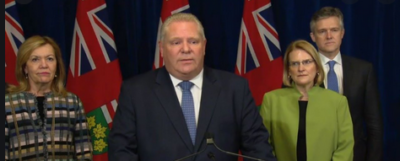 Premier does a media event almost daily – begging – beseeching the public to observe the social distancing rules. But the number of new infections is climbing – daily. The Premier is his now almost daily web cast where he brings people up to data on what is happening; what they province is doing and putting critical data into the public realm.
He often beseeches, beg the public to be careful and cautious.
A significant part of the public isn’t listening all that well.
Today the province announced a new interactive self-screening tool. It is direct and the province wants people to use it every day.
CLICK HERE to access the app.
That isn’t likely to happen – the questions asked are pretty fundamental and we suspect that after a few days the people that need to hear the message and pay attention will be the first to get bored and stop doing the self-assessment.

At the risk of being a cynic this Premier might have to announce on a Thursday morning that come Friday at noon all bars and places where people gather for non-essential purposes are closed until the following Monday.
Or perhaps a curfew to make the point. British Columbia put a curfew in place.
The number of new infections are still climbing. At some point these infections will work their way into the school system.
The public reaction will not be pretty.

 By Pepper Parr By Pepper Parr
September 12th, 2020
BURLINGTON, ON
Burlington Member of Parliament Karina Gould had a busy week. Everywhere she went federal money was being handed out – all for needed community based interests – but it did have just a hint of – is there an election on the horizon to it.
Earlier in the week there was $5 million for transit over a three year time frame.
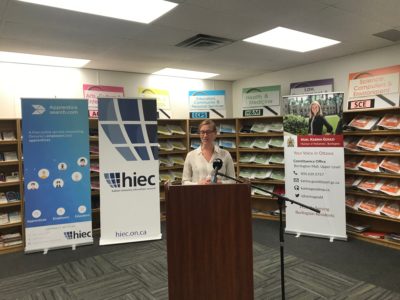 Karina Gould, Burlington MP and a member of the Liberal Cabinet, announcing federal finding for seniors. Last Friday Gould, who is a Cabinet Minister, announced an investment of $65,600 in Burlington. These funds will support projects delivered by community organizations to help seniors during the COVID-19 pandemic.
Support for these projects is being provided by the Government of Canada’s New Horizons for Seniors Program (NHSP), which fosters social inclusion and engagement of seniors by encouraging them to share their knowledge, skills and experience to stay active and engaged.
 Michelle Murry. on the left, with Minister Gould at the funding announcement at the Halton Industry Educational Council. The Halton Industry Education Council is receiving $21,000 for their project expanding online safety and technological literacy for seniors.
With this funding, HIEC will be able to expand their program to include more seniors in Canada and allow seniors to stay connected with their families, feel confident in accessing online supports and information, reduce social isolation and positively impact their mental well being.
Halton Food for Life is receiving $20,000 for their Supporting Seniors Through Accessible Food Provision. Food for Life delivers fresh food bags each week along with accessible meals for seniors who are in self isolation at home, ensuring access to healthy food to seniors across Halton during this difficult time.
The Centre for Skills Development is receiving $24,600 for their Better Together program which is designed to improve the quality of life of seniors during and after the COVID-19 Pandemic. Seniors will be able to attend workshops on how to navigate social media to stay connected, participate in home exercises and engage in conversations regarding mental health, nutrition and exploring wellness.
These projects announced today are funded through an additional investment of $20 million in funding through the New Horizons for Seniors Program.
Organizations will receive up to $25,000 in funding to offer immediate COVID-19 relief or recovery activities to seniors. The projects will include activities such as:
• promoting computer literacy and virtual activities, such as exercise classes, among seniors;
• supporting the delivery of food and medication or personalized monitoring of seniors by phone or by videoconference;
• assisting seniors with essential activities, such as visits to the doctor;
• hiring staff to replace a loss of volunteerism capacity due to the outbreak;
• providing information to seniors regarding how to care for themselves in light of experiences relating to the pandemic; and
• providing training on disease prevention, use of personal protective equipment.
Projects were selected based on equitable distribution of funding across the country, after consideration of active projects taking place in communities. Projects focusing on vulnerable populations or serving rural and remote communities were prioritized.
These additional projects will help ensure as many communities as possible across Canada have projects aiming to reduce seniors’ isolation within the community, improve their quality of life and help them maintain a social support network during the pandemic.
Background:
The New Horizons for Seniors Program (NHSP) is a federal grants and contributions program that supports projects that empower seniors in their communities and contribute to improving their health and well-being. NHSP funding supports community-based projects and pan-Canadian projects. The projects are led or inspired by seniors who are making a difference in the lives of others and their communities.
Through the NHSP, the Government of Canada encourages seniors to share their knowledge, skills and experience to the benefit of others. The objectives of the NHSP are:
 promoting volunteerism among seniors; promoting volunteerism among seniors;
engaging seniors in the community through mentoring of others;
expanding awareness of elder abuse, including financial abuse;
supporting social participation and inclusion of seniors; and
providing capital assistance for new and existing community projects and/or programs for seniors.
Since the NHSP was launched in 2004, more than 23,600 projects have been funded across Canada. Further to the Budget 2019 investment of an additional $100 million over five years, and $20 million per year ongoing, the Government of Canada will be supporting even more projects.
Community-based projects
Community-based project funding supports activities where seniors are engaged, connected and actively involved in their communities. Organizations are eligible to receive up to $25,000 in grant funding, and small grants of up to $5,000 are available to organizations that have not received funding within the last five years.
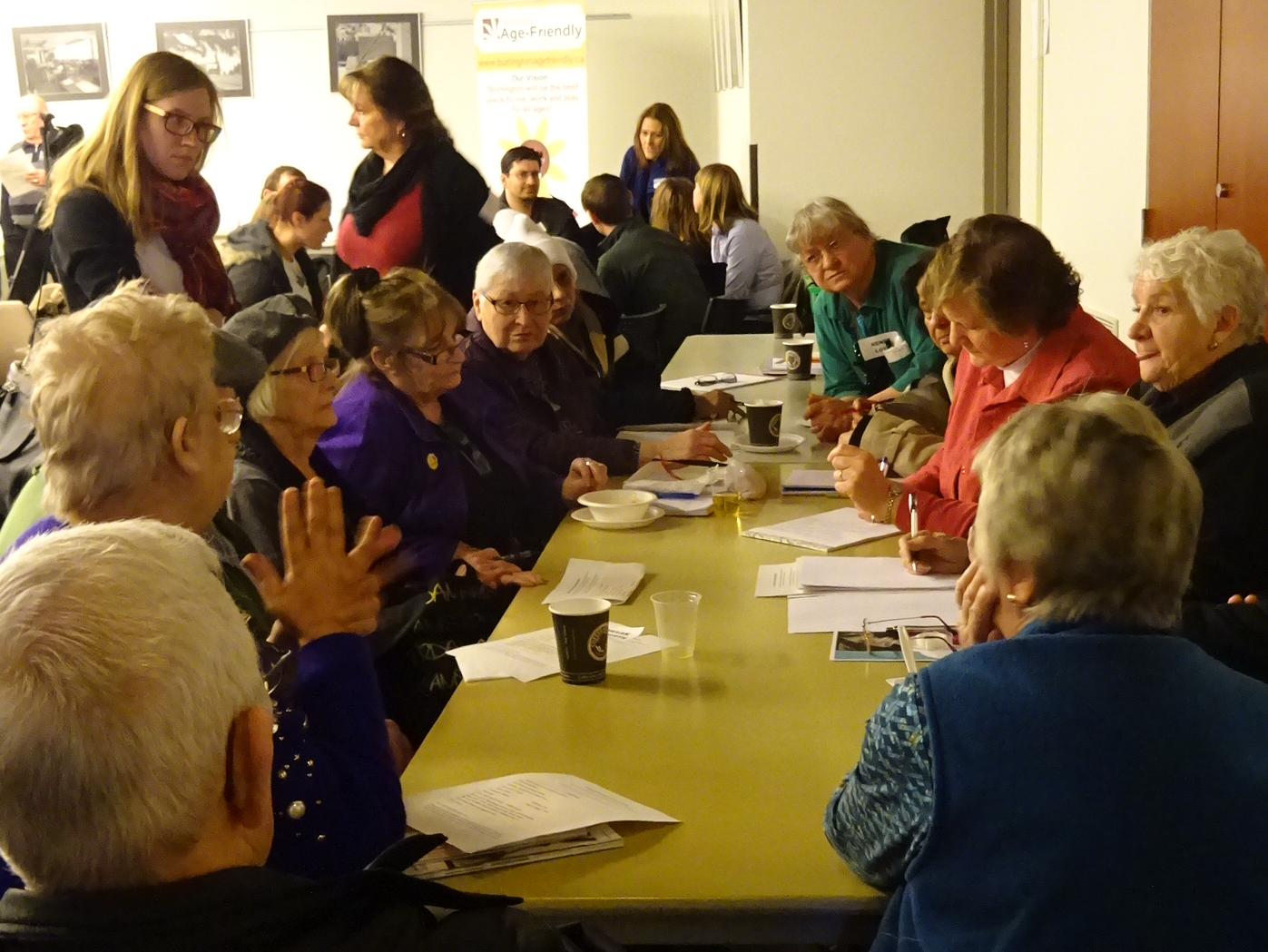 Burlington seniors at a Transit workshop discussing their specific needs. Burlington MP Karina Gould looks on.
As part of the 2019-20 NHSP community-based call for proposals, organizations were invited to apply for funding under the NHSP’s three national priorities:
preventing elder abuse and fraud, including measures to reduce crimes and harms against seniors;
supporting healthy aging in community, addressing dementia, including community supports and intergenerational housing; and
counteracting ageism in the workplace to promote labour market retention of seniors.
Burlington has, on a per capita basis, one of the largest senior populations in the province.

 By Staff By Staff
September 11th,2020
BURLINGTON, ON
This one is a little on the complex side.
The Regional Police have signed on to a web site that will aid them in finding people who are lost and help people who are lost in getting found.
The Halton Regional Police Service (HRPS) announced a new partnership with What3Words. They are one of the first police services in the country to adopt this potentially lifesaving technology and is confident that this new program will help reduce response times.
The service is called – What3words – described as an easy way to communicate an exact location. This is done by dividing the world into 3 metre squares and assigning each square a unique combination of three words.
We did say it is complex.
For example, the what3words address of the HRPS Headquarters’ front entrance is Erupt.Venomous.Linear.
Using the app, callers can communicate their precise location to call takers at the HRPS. If they do not have the app, the HRPS can send callers a text message that will identify their location and unique what3word address. HRPS communicators can then direct officers to the exact location of the caller.
 It is complex – but if it works – it could be great. “This technology could be especially helpful in situations where people have become lost hiking, or have driven off the road and are trapped in a vehicle and don’t know where they are” says Staff Sergeant Stephanie Jamieson, Communications Bureau.
“We think this will also help immensely along the 325 square kilometres of Lake Ontario policed by the HRPS Marine Unit. Boaters can become stranded or lost and struggle to communicate their location to police.”
This program is far more precise than a traditional cell phone ‘ping’ often used by emergency services.
The HRPS will begin using this technology effective immediately.
The app is available for free on iOS and Android or via the online map at what3words.com. It’s also available in more than 40 languages.
The app also works offline, making it ideal for use in rural areas of Halton that may have poor or unreliable data signal.
For more information a video on how the program works can be found HERE.

 By Pepper Parr By Pepper Parr
September 11th, 2020
BURLINGTON, ON
The taxpayers of Burlington can now get a peek at what Mayor Marianne Meed Ward has planned for a week.
This is a new feature coming out of the Mayor’s communications department.
It is described as “a regular and predictable communication of my high-level meetings, media engagements, events and regular communications”.
 An example of what the Mayor is providing is HERE. An example of what the Mayor is providing is HERE.
Look at the September 9th entry for Clearwater Development Discussion entry. Was that meeting with the developer, who has revised the plan for two medium rise buildings in what is a single dwelling community or with the ward Councillor: who was involved in that meeting? This particular development is of serious concern to a number of people in the community.
One wonders if this weekly peek is being put in place rather than a Registry that has been proposed by ward 2 Councillor Lisa Kearns.
A Registry is a list of the people that an elected official meets with on city business.
A Registry entry would set out the name of the person the Mayor or Councillor met with, the company they represented, the business that was discussed and the length of time the meeting lasted.
There are a lot of people who want to do business with the city of Burlington. Many think that the Mayor can serve their interests well and they look for an opportunity to meet with and impress the Mayor. Never hurts to have friends in high places.
A former Mayor of Burlington once told me “anything that happens in the city comes through the office of the Mayor”. A Registry is a much more disciplined document and in some municipalities there are penalties for not complying with keeping an accurate and timely Registry – no noting that you met with someone three months ago.
During the presentation of a development by a large corporation at a public meeting the senior officer of a much smaller development organization approached a Councillor who was elected for the first time in 2018. It was a very casual meeting, lasted just a few minutes during which a business card was presented. I would bet dollars to donuts that there was a follow up meeting.
And there is nothing wrong with that – but, when public money is involved – you note the event.
This is a good and commendable effort. More detail would make it what the public is entitled to.

 By Pepper Parr By Pepper Parr
September 10th 2020
BURLINGTON, ON
When funding is given to a municipality it rarely comes as a surprise.
More often than not the city and the funding body work with the municipality work out what is available and what it can be used on.
The Member or in Burlington’s case the Members of Parliament are heavily involved.
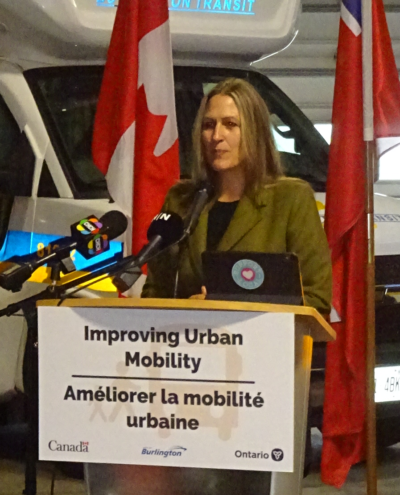 Mayor Meed Ward leading the announcement of new transit equipment. She had them dancing about the funding before they all went home. Thus the decision to lay millions of dollars on the city is something that was worked out between the federal government, the province and the city. The Region had nothing to do with this one.
The question that popped into my mind was: What does this mean to any electrification of the Burlington Transit fleet.
Every bit of professional advice Director of Transit Sue Connor got was that it was not possible to operate a fleet that was electric AND diesel. Not with the money that is available to Burlington transit. Everything about electric is different.
You have to go all in if you are going electric.
The charging stations needed to ensure that the bus batteries don’t fail are a million dollars each. It looked as if Burlington was going to need two of them.
Also on the table was the use of nitrogen as the propellant. There is a very strong argument for nitrogen over electricity.
 Director of Transit Sue Connor Sue Connor brought in a speaker who took council through the nitrogen argument explaining that Canada was at that time a bit of a leader in applying the use of nitrogen to transit.
Adding 12 diesel buses to the fleet does help Connor in meeting the demand that she hopes will come back.
Just before the covid shutdown took place transit was reporting double digit rider increases.
How quickly that ridership returns is an unknown at this point.
The 12 new 40 foot buses and the five conventional buses to replace vehicles in the fleet now are to be acquired over a three year period.
Perhaps Connors can hold getting those buses and make them electric when she does purchase.
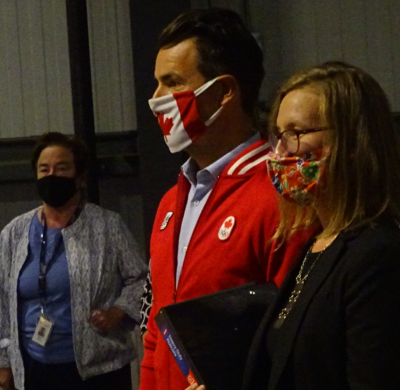 Director of Transit Sue Connor looks on while the political set announce that she is going to get 17 new buses over a three year time frame. None were to be electric – does this kill her dream of an all electric transit fleet? When Sue Connor was brought on board she made big changes at transit. There are people on staff there now who moved from other city departments to work at transit.
Connors has made the necessary changes; prior to her arrival there was some pretty incompetent leadership.
At one point a former Director of Transit had suggested that the terminal on John Street be closed and that bus tickets be bought at city hall (which closed at 4:30) or at local convenience stores around the city.
Problem was none of the convenience stores wanted to be bothered.
A lot of really stupid decisions were made before Connors took the wheel. Let’s hope that the senior levels of government that made the funds available have not killed the idea of an electric fleet for Burlington Transit.
Salt with Pepper is the musings, reflections and opinions of the publisher of the Burlington Gazette, an online newspaper that was formed in 2010 and is a member of the National Newsmedia Council.
What makes politicians dance: a funding announcement. Watch them do it.

|
|
 By Pepper Parr
By Pepper Parr Like all the other incorporated not for profit organizations – it holds an annual meeting.
Like all the other incorporated not for profit organizations – it holds an annual meeting.

















 “With this in mind, we discussed this issue, its impact on our members, the community and the Club and went through a variety of options of what we should do. Out of an abundance of caution, we have therefore decided to suspend the season at this time.
“With this in mind, we discussed this issue, its impact on our members, the community and the Club and went through a variety of options of what we should do. Out of an abundance of caution, we have therefore decided to suspend the season at this time.


 When the Free P program was implemented the annual cost of permits was charged over 11 months of the year and each permit holder saw an increase in the monthly fee. With the termination of the Free P program, permits will now once again be collected over 12 months thereby reducing the cost of the monthly permit.
When the Free P program was implemented the annual cost of permits was charged over 11 months of the year and each permit holder saw an increase in the monthly fee. With the termination of the Free P program, permits will now once again be collected over 12 months thereby reducing the cost of the monthly permit.






 Michele Bogle is a Burlington resident who writes for the Gazette on community issues. Ms Bogle has taken part in the Food Network for the second year in a row to audition for the ‘Great Chocolate Showdown’ 2020 and 2021. She made it to the second stage of auditions for ‘Wall of Chefs’ 2019 and finished top 1% of auditions last year for ‘The Great Canadian Baking Show’.
Michele Bogle is a Burlington resident who writes for the Gazette on community issues. Ms Bogle has taken part in the Food Network for the second year in a row to audition for the ‘Great Chocolate Showdown’ 2020 and 2021. She made it to the second stage of auditions for ‘Wall of Chefs’ 2019 and finished top 1% of auditions last year for ‘The Great Canadian Baking Show’.


















 That got the Hamilton people changing gears and getting really serious – even though the number to pull this off is set at $1.4 BILLION – much of which would come from the federal and provincial levels.
That got the Hamilton people changing gears and getting really serious – even though the number to pull this off is set at $1.4 BILLION – much of which would come from the federal and provincial levels.

 Shoes can be dropped off in advance at: Rolling Horse Community Cycle (650 Plains Rd E #2) & 2466 Newport St. (a house near Headon Forest Dr.) beginning on Tuesday, Sept. 22nd & up until Thursday, Sept 24th. Shoes can also be placed at the shoe strike location (tent. scheduled at Civic Square, City Hall, Brant Street) between 10am and noon on Sept. 25.
Shoes can be dropped off in advance at: Rolling Horse Community Cycle (650 Plains Rd E #2) & 2466 Newport St. (a house near Headon Forest Dr.) beginning on Tuesday, Sept. 22nd & up until Thursday, Sept 24th. Shoes can also be placed at the shoe strike location (tent. scheduled at Civic Square, City Hall, Brant Street) between 10am and noon on Sept. 25.

 Ray Rivers usually writes about politics and the environment. His grandchildren are doing elementary school as distant learners.
Ray Rivers usually writes about politics and the environment. His grandchildren are doing elementary school as distant learners.








 promoting volunteerism among seniors;
promoting volunteerism among seniors;


 An example of what the Mayor is providing is
An example of what the Mayor is providing is




